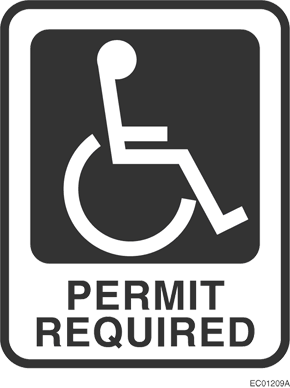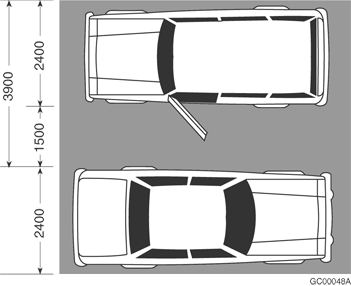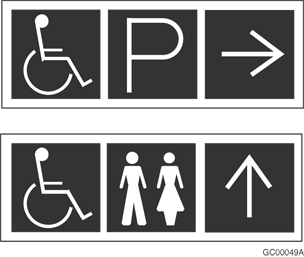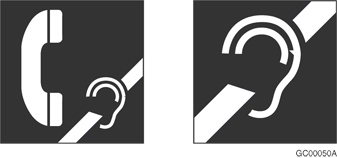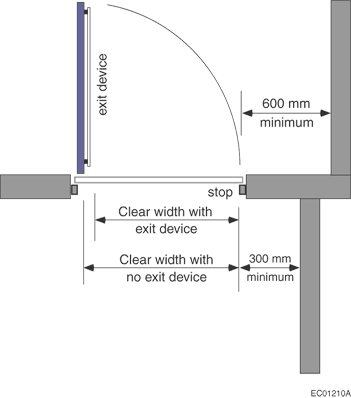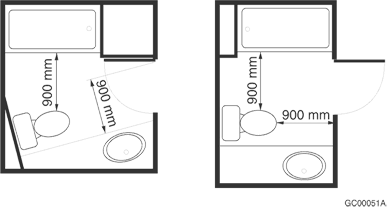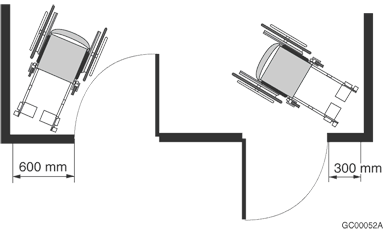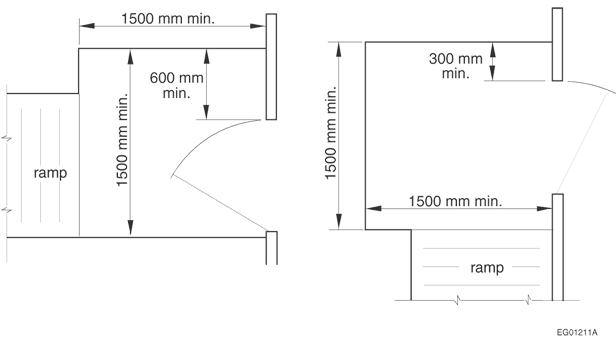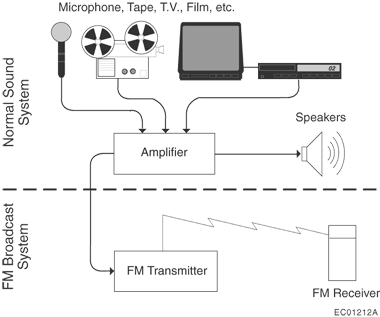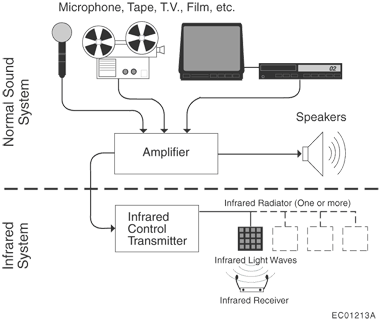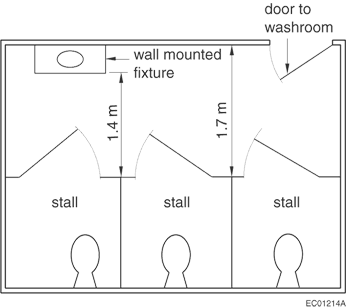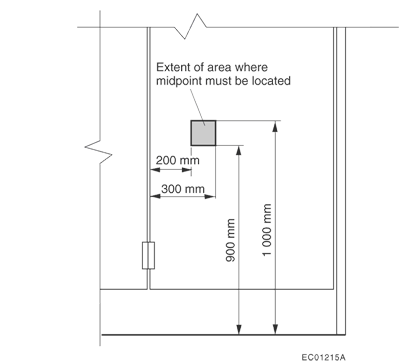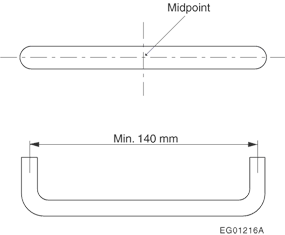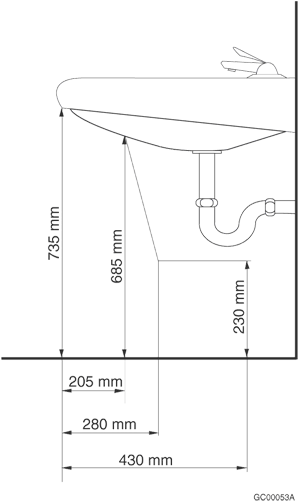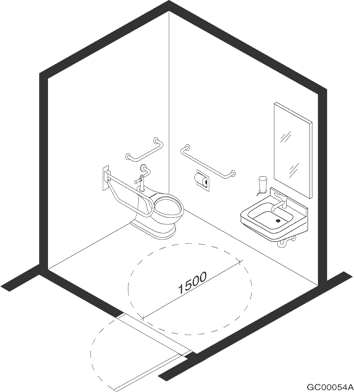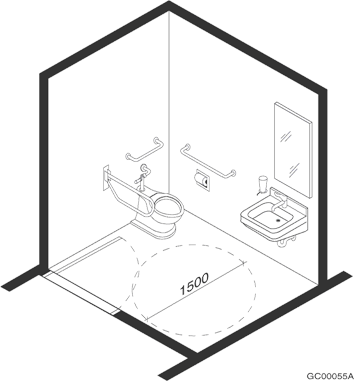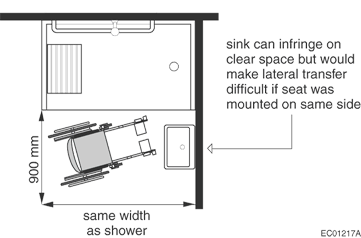Appendix A — Division B
Explanatory Material
A-3 Application of Part 3
In applying the requirements of this Part, it is intended that they be applied
with discretion to buildings of unusual configuration that do not clearly conform
to
the specific requirements, or to buildings in which processes are carried out which
make compliance with particular requirements in this Part impracticable. The
definition of “building” as it applies to this Code is general and encompasses most
structures, including those which would not normally be considered as buildings in
the layman's sense. This occurs more often in industrial uses, particularly those
involving manufacturing facilities and equipment that require specialized design
that may make it impracticable to follow the specific requirements of this Part.
Steel mills, aluminum plants, refining, power generation and liquid storage
facilities are examples. A water tank or an oil refinery, for example, has no floor
area, so it is obvious that requirements for exits from floor areas would not apply.
Requirements for structural fire protection in large steel mills and pulp and paper
mills, particularly in certain portions, may not be practicable to achieve in terms
of the construction normally used and the operations for which the space is to be
used. In other portions of the same building, however, it may be quite reasonable
to
require that the provisions of this Part be applied (e.g., the office portions).
Similarly, areas of industrial occupancy which may be occupied only periodically by
service staff, such as equipment penthouses, normally would not need to have the
same type of exit facility as floor areas occupied on a continuing basis. It is
expected that judgment will be exercised in evaluating the application of a
requirement in those cases when extenuating circumstances require special
consideration, provided the occupants' safety is not endangered.
The provisions in this Part for fire protection features installed in buildings
are intended to provide a minimum acceptable level of public safety. It is intended
that all fire protection features of a building, whether required or not, will be
designed in conformance with good fire protection engineering practice and will meet
the appropriate installation requirements in relevant standards. Good design is
necessary to ensure that the level of public safety established by the Code
requirements will not be reduced by a voluntary installation.
Firefighting Assumptions
The requirements of this Part are based on the assumption that
firefighting capabilities are available in the event of a fire emergency.
These firefighting capabilities may take the form of a paid or volunteer
public fire department or in some cases a private fire brigade. If
these firefighting capabilities are not available, additional fire
safety measures may be required.
Firefighting capability can vary from municipality to municipality.
Generally, larger municipalities have greater firefighting capability
than smaller ones. Similarly, older, well established municipalities
may have better firefighting facilities than newly formed or rapidly
growing ones. The level of municipal fire protection considered to
be adequate will normally depend on both the size of the municipality
(i.e., the number of buildings to be protected) and the size of buildings
within that municipality. Since larger buildings tend to be located
in larger municipalities, they are generally, but not always, favoured
with a higher level of municipal protection.
Although it is reasonable to consider that some level of municipal
firefighting capability was assumed in developing the fire safety
provisions in Part 3, this was not done on a consistent or defined basis. The requirements in the Code, while developed
in the light of commonly prevailing municipal fire protection levels,
do not attempt to relate the size of building to the level of municipal
protection. The responsibility for controlling the maximum size of
building to be permitted in a municipality in relation to local firefighting
capability rests with the municipality. If a proposed building is
too large, either in terms of floor area or building height, to receive
reasonable protection from the municipal fire department, fire protection
requirements in addition to those prescribed in this Code, may be
necessary to compensate for this deficiency. Automatic sprinkler protection
may be one option to be considered.
Alternatively, the municipality may, in light of its firefighting
capability, elect to introduce zoning restrictions to ensure that
the maximum building size is related to available municipal fire protection
facilities. This is, by necessity, a somewhat arbitrary decision and
should be made in consultation with the local firefighting service,
who should have an appreciation of their capability to fight fires.
The requirements of Subsection 3.2.3. are intended
to prevent fire spread from thermal radiation assuming there is adequate
firefighting available. It has been found that periods of from 10
to 30 minutes usually elapse between the outbreak of fire in a building
that is not protected with an automatic sprinkler system and the attainment
of high radiation levels. During this period, the specified spatial
separations should prove adequate to inhibit ignition of an exposed
building face or the interior of an adjacent building by radiation.
Subsequently, however, reduction of the fire intensity by firefighting
and the protective wetting of the exposed building face will often
be necessary as supplementary measures to inhibit fire spread.
In the case of a building that is sprinklered throughout, the
automatic sprinkler system should control the fire to an extent that
radiation to neighbouring buildings should be minimal. Although there
will be some radiation effect on a sprinklered building from a fire
in a neighbouring building, the internal sprinkler system should control
any fires that might be ignited in the building and thereby minimize
the possibility of the fire spreading into the exposed building. NFPA 80A, “Protection of Buildings from Exterior Fire Exposures,” provides additional information on the possibility of fire spread at building exteriors.
The water supply requirements for fire protection installations
depend on the requirements of any automatic sprinkler installations
and also on the number of fire streams that may be needed at any fire,
having regard to the length of time the streams will have to be used.
Both these factors are largely influenced by the conditions at the
building to be equipped, and the quantity and pressure of water needed
for the protection of both the interior and exterior of the building
must be ascertained before the water supply is decided upon. Acceptable
water supplies may be a public waterworks system that has adequate
pressure and discharge capacity, automatic fire pumps, pressure tanks,
manually controlled fire pumps in combination with pressure tanks,
gravity tanks, and manually controlled fire pumps operated by remote
control devices at each hose station.
A-3.1.2. Use Classification
The purpose of classification is to determine which requirements apply. This Code
requires classification in accordance with every major occupancy for which the
building is used or intended to be used. Where necessary, an application clause has
been inserted in this Part to explain how to choose between the alternative
requirements which multiple occupancy classification may present.
A-3.1.2.1.(1) Major Occupancy Classification
The following are examples of the major occupancy classifications described in Table 3.1.2.1.:
- Group A, Division 1
- Motion picture theatres
- Opera houses
- Television studios admitting a viewing audience
- Theatres, including experimental theatres
- Group A, Division 2
- Art galleries
- Auditoria
- Bowling alleys
- Churches and similar places of worship
- Clubs, nonresidential
- Community halls
- Courtrooms
- Dance halls
 Daycare facilities for children
Daycare facilities for children
- Exhibition halls (other than classified in Group E)
- Gymnasia
- Lecture halls
- Libraries
- Licensed beverage establishments
- Museums
- Passenger stations and depots
- Recreational piers
- Restaurants
- Schools and colleges, nonresidential
- Undertaking premises
- Group A, Division 3
- Arenas
- Indoor swimming pools, with or without spectator seating
- Rinks
- Group A, Division 4
- Amusement park structures (not elsewhere classified)
- Bleachers
- Grandstands
- Reviewing stands
- Stadia
- Group B, Division 1
- Jails
- Penitentiaries
- Police stations with detention quarters
- Prisons
- Psychiatric hospitals with detention quarters
- Reformatories with detention quarters
- Group B, Division 2
 Care facilities with treatment
Care facilities with treatment
- Convalescent
 /recovery/rehabilitation centres with treatment
/recovery/rehabilitation centres with treatment
 Hospices with treatment
Hospices with treatment
- Hospitals
- Infirmaries
- Nursing homes
 with treatment
with treatment
- Psychiatric hospitals without detention quarters
- Respite centres with treatment
 Group B, Division 3
Group B, Division 3- Assisted/supportive living facilities
- Care facilities without treatment
- Children’s custodial homes
- Convalescent/recovery/rehabilitation centres without treatment
- Group homes
- Hospices without treatment
- Nursing homes without treatment
- Reformatories without detention quarters
- Respite centres without treatment

- Group C
- Apartments
- Boarding houses
- Clubs, residential
- Colleges, residential
- Convents
- Dormitories
- Hotels
- Houses
- Lodging houses
- Monasteries
- Motels
- Schools, residential
- Group D
- Banks
- Barber and hairdressing shops
- Beauty parlours
- Dental offices
- Dry cleaning establishments, self-service, not using flammable or explosive solvents or cleaners
- Laundries, self-service
- Medical offices
- Offices
- Police stations without detention quarters
- Radio stations
- Small tool and appliance rental and service establishments
- Group E
- Department stores
- Exhibition halls
- Markets
- Shops
- Stores
- Supermarkets
- Group F, Division 1
- Bulk plants for flammable liquids
- Bulk storage warehouses for hazardous substances
- Cereal mills
- Chemical manufacturing or processing plants
- Distilleries
- Dry cleaning plants
- Feed mills
- Flour mills
- Grain elevators
- Lacquer factories
- Mattress factories
- Paint, varnish and pyroxylin product factories
- Rubber processing plants
- Spray painting operations
- Waste paper processing plants
- Group F, Division 2
- Aircraft hangars
- Box factories
- Candy plants
- Cold storage plants
- Dry cleaning establishments not using flammable or explosive solvents or cleaners
- Electrical substations
- Factories
- Freight depots
- Helicopter landing areas on roofs
- Laboratories
- Laundries, except self-service
- Mattress factories
- Planing mills
- Printing plants
- Repair garages
- Salesrooms
- Service stations
- Storage rooms
- Television studios not admitting a viewing audience
- Warehouses
- Wholesale rooms
- Woodworking factories
- Workshops
- Group F, Division 3
- Creameries
- Factories
- Laboratories
 Light-aircraft hangars (storage only)
Light-aircraft hangars (storage only)
- Power plants
- Salesrooms
- Sample display rooms
- Storage garages, including open air parking garages
- Storage rooms
- Warehouses
- Workshops

A-3.1.2.3.(1) Arena Regulation
The use of an arena is regulated in the British Columbia Fire Code.

A-3.1.2.6. Group A, Division 2, Low Occupant Load
A suite of Group A, Division 2 Assembly is permitted to be classified as a Group
D, Business and personal services occupancy provided the requirements of Article 3.1.2.6. are complied with. This re-classification permits the suite to be located in a building
to which Part 9 of the Code is applicable.
 A-3.1.2.8. Daycare Facilities for Children
A-3.1.2.8. Daycare Facilities for ChildrenA daycare facility for children is typically occupied for a period of less than 24
hours each day (i.e., is not a residential facility). The term “daycare” is not meant
to exclude facilities that provide short term care during the night for a period of
less than 24 hours each day. (See also A-3.3.2.16.)

A-3.1.4.2.(1)(c) Thermal Barrier in Combustible Construction
Any thermal barrier that is accepted under
the requirements of Sentence 3.1.5.12.(2) for noncombustible construction is also acceptable for combustible construction.
A-3.1.4.3.(1)(b)(i) Raceway Definition
The term raceway is defined in CSA C22.1, “Canadian Electrical Code, Part I,” and includes both rigid and flexible conduit.
A-3.1.4.3.(1) Wire and Cable Equivalence
Electrical wires and cables that conform to the requirements
of Sentence 3.1.5.18.(1) are deemed to satisfy the requirements of Sentence 3.1.4.3.(1).
A-3.1.5.4.(1) Skylight Spacing
The minimum spacing dimensions for skylight assemblies are based
on the distance that flame must travel along a flat ceiling surface.
If ceilings have projecting beams or other features that would increase
the distance the flame would have to travel along the surface, the
distances specified may be measured accordingly.
A-3.1.5.5.(1) Combustible Cladding
These requirements allow for exterior wall assemblies incorporating combustible
cladding system elements on buildings of noncombustible construction.
 For the purposes of this Article, a cladding system is considered as those materials outboard of the sheathing membrane.
For the purposes of this Article, a cladding system is considered as those materials outboard of the sheathing membrane. Since the tested assemblies must be representative of actual construction, the performance of the
entire assembly is assessed with regard to its ability to resist flame propagation
up the outside of a building. The thermal barrier protection limits the impact of
an
interior fire on the wall assembly. These requirements, however, do not waive others
specifically intended for the protection of combustible insulation in buildings of
noncombustible construction.
Since the tested assemblies must be representative of actual construction, the performance of the
entire assembly is assessed with regard to its ability to resist flame propagation
up the outside of a building. The thermal barrier protection limits the impact of
an
interior fire on the wall assembly. These requirements, however, do not waive others
specifically intended for the protection of combustible insulation in buildings of
noncombustible construction.
 For the purposes of this Article, a cladding system is considered as those materials outboard of the sheathing membrane.
For the purposes of this Article, a cladding system is considered as those materials outboard of the sheathing membrane. Since the tested assemblies must be representative of actual construction, the performance of the
entire assembly is assessed with regard to its ability to resist flame propagation
up the outside of a building. The thermal barrier protection limits the impact of
an
interior fire on the wall assembly. These requirements, however, do not waive others
specifically intended for the protection of combustible insulation in buildings of
noncombustible construction.
Since the tested assemblies must be representative of actual construction, the performance of the
entire assembly is assessed with regard to its ability to resist flame propagation
up the outside of a building. The thermal barrier protection limits the impact of
an
interior fire on the wall assembly. These requirements, however, do not waive others
specifically intended for the protection of combustible insulation in buildings of
noncombustible construction.
These requirements are predicated upon the assumption that the manufacturing
process and field installation procedure are both carried out under an independent
quality assurance program designed to confirm that the product and its application
are consistent with the system as tested.
 The requirements of Article 3.1.5.5. are not intended to limit the permissions for minor combustible components permitted by Article 3.1.5.2.
The requirements of Article 3.1.5.5. are not intended to limit the permissions for minor combustible components permitted by Article 3.1.5.2.

A-3.1.5.5.(3) Flame-Spread Distance
The maximum flame-spread distance refers to the distance between
the top of the opening and the highest observable instance of flaming
along the wall assembly and thus allows intermittent flaming to a
height of 5 m above the opening.
A-3.1.5.5.(4) Heat Flux Measurement
The heat flux to the assembly referred to in Sentence 3.1.5.5.(4) is the maximum one-minute averaged heat flux measured by transducers located 3.5 m above the top of the opening. The intent
of this criterion is to limit the spread of fire on the wall assembly
to a height of 3.5 m above the opening. Since the exact
location of flaming on the exterior surface of a wall assembly can
be influenced by the presence of furring strips, cavities, etc., in
the assembly, which could channel the flame away from a heat flux
transducer, sufficient transducers should be located at any given
height to intercept any flaming that could occur along the assembly.
The exact position of the transducers will depend on the location
of cavities, joints, studs or furring strips in the assembly.
A-3.1.5.12.(2)(e) Foamed Plastic Insulation Protection
The standard fire exposure temperature in CAN/ULC-S101, “Fire Endurance Tests of Building Construction and Materials,” is the same as in CAN/ULC-S124, “Test for the Evaluation of Protective Coverings for Foamed Plastic.” A thermal barrier that, when tested in conformance with CAN/ULC-S101, does not exceed an average temperature rise of 140°C on its unexposed face after a period of 10 min satisfies this requirement.
A-3.1.5.18.(1) Wire and Cable Flammability
In regulating the flammability characteristics of electrical wires and cables
installed in a building, it is intended that the requirements of this Sentence and
of other similar Sentences in the Code apply to wires and cables that are
essentially a part of the distribution systems for power or communications. These
distribution systems will normally include branch circuits that terminate at an
outlet box in the space to be served and at that location cable terminators or plugs
for individual items of equipment will be plugged in.
A-3.1.6. Tents and Air-Supported Structures
The requirements in this Subsection are intended to be limited to certain types of
structure. For instance, the word “tent” as used in the Code is intended
to refer to a temporary shelter which is used at an open air event such as a fair
or
an exhibition. A tent will normally be constructed of a fabric held up by poles and
attached to the ground by ties. The requirements for tents, however, are not
intended to be applied to fabric structures located on buildings.
The term “air-supported structure,” as used in the Code, refers to an
envelope which is held up by air pressure alone and which is erected on the ground
or above a basement. The structure will usually require ballast or a positive ground
anchorage system around the entire perimeter to secure it to the ground or basement.
To reinforce this intent, the Code prohibits the location of an air-supported
structure above the first storey of any building.
The requirements of Subsection 3.1.6. are not intended to apply to
air-supported roof assemblies on buildings, such as domed stadia, or to other types
of air-supported structures, such as those over swimming pools situated on the roofs
of buildings, which would not be anchored at or near ground level. These assemblies
or structures are normally designed and evaluated on the basis of alternative
solutions as permitted by Article 1.2.1.1. of Division A.
A-3.1.8.1.(1)(b) Barrier to Control Smoke Spread
Although a fire separation is not always required to have a
fire-resistance rating, the fire separation should act as a barrier
to the spread of smoke and fire until some response is initiated.
 When choosing products for fire stopping, the physical characteristics of the material used at the joints as well
as the nature of the assembly and its potential movement should be
taken into consideration.
When choosing products for fire stopping, the physical characteristics of the material used at the joints as well
as the nature of the assembly and its potential movement should be
taken into consideration.
If the fire-resistance rating of a fire separation
is waived on the basis of the presence of an automatic sprinkler system,
it is intended that the fire separation will be constructed so that
it will remain in place and act as a barrier against the spread of
smoke for a period of time until the sprinklers have actuated and
controlled the fire.
A-3.1.8.1.(2) Installation of Closures
Although there is no explicit performance statement in the NBC that means of egress
should be free of smoke, it is the intent that during the period when occupants are
using a means of egress to evacuate from a floor area, the smoke contamination should
not reach levels that would inhibit movement to the exit. This is particularly critical
for persons with disabilities, who may not move at the same rate as other persons
and who could be more susceptible to the effects of smoke contamination. NFPA 80, “Fire Doors and Other Opening Protectives,” requires that a fire door protecting a means of egress be designed to minimize the possibility of smoke passing through the opening.
Although self-closing devices are not required for all doors in a fire separation
(see Article 3.1.8.11.), it is assumed that in a fire situation every door in a fire separation is closed. Article 3.3.3.5. prohibits grilles and similar openings for certain doors in hospitals and nursing homes with treatment.
Although fire dampers that release on the fusion of a fusible link will help to control
the spread of fire, a substantial quantity of smoke could have passed through the
opening before that event. They are frequently located below the upper levels of a
room and so the release of the fusible link of the fire damper that protects an opening
will be delayed until the temperature at the level of the opening becomes high enough
to fuse the link.
Similar concern has to be considered for other closure devices that are permitted
to remain open on fusible links, and their location should be restricted in accordance
with NFPA 80 and the NBC, except where their installation in another location will not allow the products of combustion to spread into means of egress.
A-3.1.8.3.(4) Fire Separation Continuity
The continuity of a fire separation where it abuts against another
fire separation, a floor, a ceiling or an exterior wall assembly is
maintained by filling all openings at the juncture of the assemblies
with a material that will ensure the integrity of the fire separation
at that location.
A-3.1.8.9.(5) Fire Damper Access
It is intended that an access door be provided in the duct and, if
the duct is enclosed with an architectural finish, that a second access
door be provided through that finish.
A-3.1.8.16.(1) Wired Glass and Glass Block
The permission to include wired glass and glass block in doors
and fire separations between an exit and the adjacent floor area does
not permit the inclusion of those items in fire separations between
exits and other parts of the building that are not included in the
floor area. Examples include other exit facilities and vertical service
spaces, including those used for building services and elevator hoistways.
A-3.1.8.17.(1) Fire-Protection Rating for Doors
The provisions in Articles 3.1.8.15., 3.1.8.16. and 3.1.8.17. do not waive a requirement for a door to have a fire-protection rating. To achieve this rating in a door test, it
may be necessary to limit the area of glass in the door. If this area
is less than the area limits of Article 3.1.8.16., it is the governing criterion. Conversely, if the area limits of Article 3.1.8.16. are less than the area required to achieve a fire-protection rating, then
the area limits of this Article govern.
A-3.1.9. Penetrations
In the application
of Subsection 3.1.9., a building service is considered
to penetrate an assembly if it passes into or through the assembly.
In some situations a service item enters an assembly through a membrane
at one location, runs within the assembly, and then leaves the assembly
through a membrane at another location.
 The term “membrane penetration” usually designates an opening made through one side (wall, floor or ceiling membrane)
of an assembly, whereas the term “through-penetration” designates
an opening that passes through an entire assembly. Fire stopping of
membrane penetrations involves installing a material, device or construction
to resist for a prescribed time period the passage of flame and heat
through openings in a protective membrane caused by cables, cable
trays, conduit, tubing, pipes or similar items. Fire stopping of a
through-penetration involves installing an assemblage of specific
materials or products that are designed, tested and fire-resistance
rated to resist for a prescribed period of time the spread of fire
through penetrations.
The term “membrane penetration” usually designates an opening made through one side (wall, floor or ceiling membrane)
of an assembly, whereas the term “through-penetration” designates
an opening that passes through an entire assembly. Fire stopping of
membrane penetrations involves installing a material, device or construction
to resist for a prescribed time period the passage of flame and heat
through openings in a protective membrane caused by cables, cable
trays, conduit, tubing, pipes or similar items. Fire stopping of a
through-penetration involves installing an assemblage of specific
materials or products that are designed, tested and fire-resistance
rated to resist for a prescribed period of time the spread of fire
through penetrations.
Products for fire stopping within a barrier are required to
address movement of the assembly and to control smoke spread; as such,
the flexibility of the material used at the flexible joints as well
as the nature of the assembly and its potential movement must be taken
into consideration.

A-3.1.9.1.(1)(b)  Cast in Place Penetration
Cast in Place Penetration
 Cast in Place Penetration
Cast in Place Penetration
The intention behind the use of the term “cast in place” is to reinforce that
there are to be no gaps between the building service  or penetrating item
or penetrating item and the membrane
and the membrane  or assembly
or assembly it penetrates. The term “cast in place” describes a typical means of fire stopping for
a service penetration through a concrete slab or wall.
it penetrates. The term “cast in place” describes a typical means of fire stopping for
a service penetration through a concrete slab or wall.
 or penetrating item
or penetrating item and the membrane
and the membrane  or assembly
or assembly it penetrates. The term “cast in place” describes a typical means of fire stopping for
a service penetration through a concrete slab or wall.
it penetrates. The term “cast in place” describes a typical means of fire stopping for
a service penetration through a concrete slab or wall.

 A-3.1.9.1.(1)(c) Tightly Fitted Penetrations
A-3.1.9.1.(1)(c) Tightly Fitted PenetrationsThe intention behind the term "tightly fitted" is to reinforce that there are to be
no substantial gaps between the building service or penetrating item and the membrane
or assembly it penetrates.
A-3.1.9.2.(1) Penetration of Fire Separations by Electrical Boxes
The provisions dealing with outlet
boxes assume size, quantities and concentrations of partial depth
penetrations that would not significantly affect the fire resistance
of the assembly, including the temperature rise on the unexposed side
of a wall. Sentence 3.1.9.2.(1) is not intended to allow large electrical distribution and control boxes to be recessed into an assembly
required to have a fire-resistance rating unless they were incorporated
in the assembly at the time of testing.
A-3.1.10.2.(4) Firewall Construction
Inherent in the use of a firewall is the intent that this specialized
wall construction provide the required fire-resistance rating while
also being designed to resist physical damage—arising out of normal
use—that would compromise the rating of the assembly. Traditionally,
this has been accomplished by prescribing the use of noncombustible
materials, which was in fact restricted to concrete or masonry. Sentences 3.1.10.2.(3) and (4) are intended to retain both of the characteristics of firewalls, while permitting greater flexibility
in the use of materials and designs. The fire-resistance rating and
damage protection attributes of a firewall may be provided by a single
fire- and damage-resistant material such as concrete or masonry, by
a fire- and damage-resistant membrane on a structural frame, or by
separate components—one that provides the fire-resistance rating and
another one that protects the firewall against damage.
If the firewall is composed of separate components, the fire-resistance
rating of the fire-resistive component needs to be determined for
this assembly on its own. In addition, if the damage protection component
is physically attached to the fire-resistive component (for example,
as a sacrificial layer), then for the purposes of determining the
overall performance of the assembly, it is also necessary to determine
through testing whether failure of the damage protection component
during a fire affects the performance of the fire-resistive component.
A-3.1.11.5.(1) Fire Blocks in Combustible Construction
Combustible construction referred to in Sentence 3.1.11.5.(1) includes all types of construction that do not comply with the requirements for noncombustible construction. All the elements within the
concealed space can be combustible, unless required to be of noncombustible
materials (e.g., certain categories of pipework and ducts), but the value of the
flame-spread rating of the combustible materials determines the permitted extent of
the concealed space between fire blocks. The materials to be considered include all
construction materials regulated by this Code, including the framing and building
services that are located in the concealed space.
 A-3.1.11.7.(6) Integrity of Fire Blocks
A-3.1.11.7.(6) Integrity of Fire BlocksSentence 3.1.11.7.(6) together with Article 3.1.9.1., is intended to ensure that the integrity of fire blocks is maintained at areas where they are penetrated. This requirement is satisfied
by the use of generic fire stops such as mineral wool, gypsum plaster
or Portland cement mortar, as well as rated fire stops.

A-3.1.11.7.(7) Fire Blocks
Figure A-3.1.11.7.(7) shows the location of the semi-rigid fibre insulation board at the intersection between walls and floors in
wood-frame construction. The figure is intended to illustrate the fire block detail
and not a design of a fire separation.
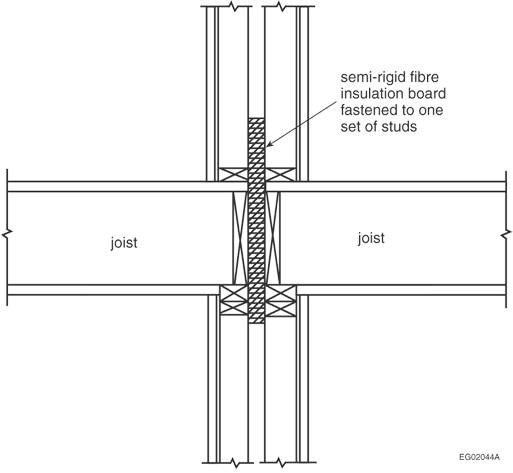
Figure A-3.1.11.7.(7)
Fire stopping
A-3.1.13.2.(2) Folding Partition
Folding partitions used to divide a space into separate rooms are
not considered as doors for the purposes of this Sentence.
A-3.2.1.1.(3) Mezzanine Area
The following sketches illustrate the intent of this Sentence.
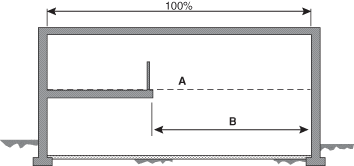
Figure A-3.2.1.1.(3)-A
Concept of Horizontal Plane
Notes to Figure A-3.2.1.1.(3)-A:
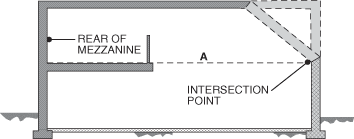
Figure A-3.2.1.1.(3)-B
Intersection Point
Notes to Figure A-3.2.1.1.(3)-B:
|
|
|
| (1) |
This Figure describes Clause 3.2.1.1.(3)(a).
|
| (2) |
The length of the horizontal plane (A) is taken from the rear of
the mezzanine to the point at which it intersects a wall, ceiling, roof or other
major component.
|
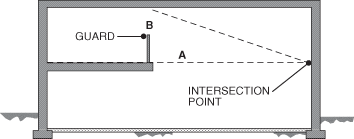
Figure A-3.2.1.1.(3)-C
Projections, Including Guards
Notes to Figure A-3.2.1.1.(3)-C:
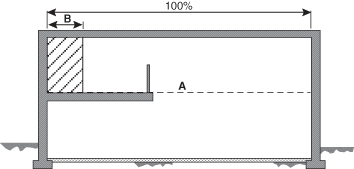
Figure A-3.2.1.1.(3)-D
Enclosed Spaces within a Mezzanine
Notes to Figure A-3.2.1.1.(3)-D:
|
|
|
| (1) |
This Figure describes Sentence 3.2.1.1.(7).
|
| (2) |
The horizontal plane is demonstrated by the dashed line,
A.
|
| (3) |
Up to 10% of the horizontal plane may be enclosed. This must be
located so as to avoid contravening the open requirements of Clause 3.2.1.1.(3)(b); in effect no dead areas are
permitted.
|
If a floor has more than one mezzanine, each may be treated individually. For
example in a one storey building with five tenancies, each tenant would be permitted
to have a mezzanine up to the limits indicated, without the building being
considered two storeys in building height. However, should one of the mezzanines
exceed any of the limitations the building would then be considered to be two
storeys in building height.
Regarding the floor space under a mezzanine, there are no restrictions on
partition construction in this area. The space on the floor beyond the mezzanine,
i.e. below the open portion of the horizontal plane should, with discretion, be
visually open to view from the mezzanine.

A-3.2.1.1.(4) Mezzanines in Suites
The defined term "suite" in this case could be equally applicable to a suite in an
apartment or commercial building, or even an entire storey such as may occur in a
curling rink. There may be more than one enclosed mezzanine in the suite but in no
instance can the combined total mezzanine area exceed 10 per cent of the suite in
which they are located.
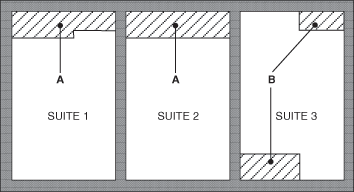
Figure A-3.2.1.1.(4)-A
Mezzanines in Suites
Notes to Figure A-3.2.1.1.(4)-A:
|
|
|
| (1) |
This Figure describes Sentence 3.2.1.1.(4).
|
| (2) |
Mezzanines up to 10% of area of a suite (A) may be
enclosed.
|
| (3) |
More than one mezzanine (B) is permitted in a suite provided the
total area of mezzanines does not exceed 10% of the suite in which they
are located.
|
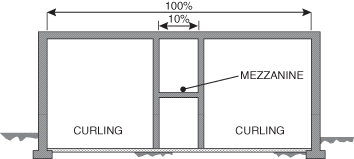
Figure A-3.2.1.1.(4)-B
Mezzanines in Multi-Room Suites
Notes to Figure A-3.2.1.1.(4)-B:
|
|
|
| (1) |
This Figure describes Clauses 3.2.1.1.(4)(a) and (b).
|
| (2) |
The curling rink has several ‘rooms,’ but should be regarded as
‘one suite.’ The enclosed mezzanine may be up to 10% of the area of the
entire suite.
|
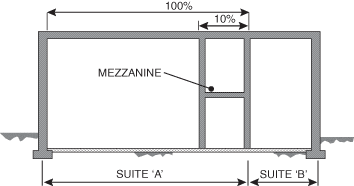
Figure A-3.2.1.1.(4)-C
Mezzanines in Multi-Tenanted Suites
Notes to Figure A-3.2.1.1.(4)-C:
|
|
|
| (1) |
This Figure describes Clauses 3.2.1.1.(4)(a) and (b).
|
| (2) |
In this example, the 10% of the suite area is of Suite ‘A’ as if
it is part of that series of rooms, or suite. It has no user of tenant
relationship with Suite ‘B.’ (Suite ‘B’ may also have 10% of totally
enclosed mezzanines).
|
A-3.2.1.1.(8) Accessible Service Space
These service spaces are often referred to as interstitial spaces and are designed
to allow service personnel to enter and undertake maintenance or installation within
the space. Catwalks or flooring are usually included to provide a walking or access
surface. Even when flooring is included, it is not intended that the interstitial
space should be considered as a storey for the purposes of the Code unless the space
is used for purposes other than servicing or the storage of materials and equipment
to be used for building services within that space.
A-3.2.2.2.(1) Special and Unusual Structures
Examples of structures which cannot be identified with the descriptions
of buildings in Articles 3.2.2.20. to 3.2.2.88. include grain elevators, refineries and towers. Publications that may be consulted to establish good engineering
practice for the purposes of Article 3.2.2.2. include the NFPA Fire Protection Handbook, Factory Mutual Data Sheets, and publications
of the Society for Fire Protection Engineering.
A-3.2.2.18.(2) Sprinkler Extent
A literal interpretation of Article 3.2.2.6. and Sentences 3.2.2.4.(1) and (2) could require installation of an automatic sprinkler system throughout all storeys of a building regardless of options in Articles 3.2.2.20. to 3.2.2.88. to construct one or more storeys without installation of sprinklers. It is the intent of the Code that all storeys below a storey in which
an
automatic sprinkler system is installed should also be protected by an automatic
sprinkler system to ensure that a fire in a lower storey does not incapacitate the
automatic sprinkler system or overwhelm an automatic sprinkler system in an upper
storey. Persons in an upper storey in which waivers or reductions of other fire
safety systems are permitted would be exposed to an increased risk from a fire on
a
lower storey. This concept also applies to situations in which an automatic
sprinkler system has been installed within a floor area in order to modify other
safety requirements applying within the floor area. If the uppermost storey or
storeys of a building can be constructed without the installation of an automatic
sprinkler system it is not necessary that an automatic sprinkler system required in
a lower storey be extended into the upper storey or storeys.
A-3.2.2.35.(4) Sprinkler Requirements
Spaces in a building of Group A, Division 4 occupancy that
are intended to be equipped with sprinklers include, but are not limited
to, dressing and changing rooms, concession stands and areas, toilet
rooms, locker rooms, storage areas, service rooms, offices and other
spaces that provide service to the building. The enclosure of seating
areas with glazing needs special consideration in determining the
requirements for sprinklers. For example, if the enclosed area is
used for the consumption of food and beverages, it should be classified
as Group A, Division 2 and the appropriate requirements of that classification
applied. Enclosure of limited spaces above seating areas for press
and media purposes is not considered to require the installation of
sprinklers.
 A-3.2.3. Fire Protection Related to Limiting Distance versus Separation Between Buildings
A-3.2.3. Fire Protection Related to Limiting Distance versus Separation Between BuildingsCode provisions that address protection against fire spread from building to
building use the limiting distance (see the definition in Article 1.4.1.2. of Division A) for a building rather than using the distance between adjacent buildings on separate properties, since this
would result in situations where the design and construction of a building on one
property affects the design and construction of a building on an adjacent
property.
The Code requirements that deal with reducing the probability of
building-to-building fire spread were originally developed based on the assumption
that the exposing building faces of adjacent buildings are of similar size and
configuration, and are equidistant from the shared property line. Where buildings
are of different sizes, the smaller building may be subject to a higher heat flux
in
the event of a fire compared to the larger building. Where buildings are closely
spaced and not equidistant from the property line, the construction of the building
with the greater limiting distance does not recognize the proximity of the building
with the lesser limiting distance.
The Code has more stringent requirements for buildings with lesser limiting
distance as regards the maximum area and spacing of unprotected openings, and the
construction, cladding and fire resistance of walls. This increased stringency
recognizes that the fire hazard is greater where buildings are closer together and
that adjacent buildings may have exposing building faces of different sizes,
configurations or limiting distances, which could further increase the
hazard.
The authority having jurisdiction may also address limiting distances through
legal agreements with the parties involved that stipulate that the limiting distance
be measured to a line that is not the property line. Such agreements would normally
be registered with the titles of both properties.

A-3.2.3.1.(4) Spatial Separation Design
In the application of Sentences 3.2.3.1.(3) and (4) it is intended that Sentence (3) be used first to establish the basic requirements for the exterior wall in terms of fire-resistance rating,
type of construction and type of cladding. The percentage of unprotected openings
determined from the application of Sentence (3) would be unnecessarily restrictive if the actual unprotected openings occur in a
plane that is set back from the front of the building face.
Sentence (4) applies to the calculation of the allowable percentage of unprotected openings based upon projection onto a
plane that is in front of all unprotected openings. The application of these two
Sentences is shown in Figure A-3.2.3.1.(4). The modifications
permitted by Article 3.2.3.12. would be applied, if applicable, to the area of unprotected openings derived from Sentence (4).
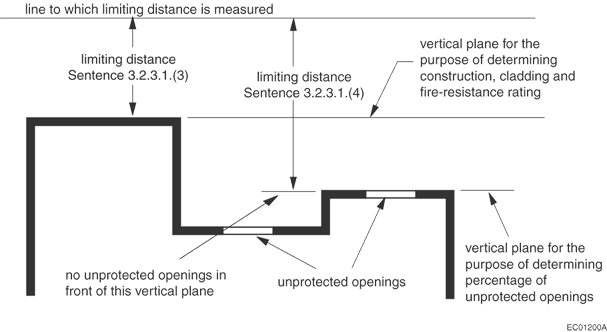
Figure A-3.2.3.1.(4)
Spatial separation design
 A-3.2.3.1.(8) Intervention Time and Limiting Distance
A-3.2.3.1.(8) Intervention Time and Limiting DistanceThe total time from the start of a fire until fire suppression by the fire department
depends on the time taken for a series of actions. Sentence 3.2.3.1.(8) is only concerned with the time from receipt of notification of a fire by the fire department until the arrival of the first fire department vehicle at the building.
It specifies a 10-min time limit which must be met in more than 90% of the calls to
the building served by the fire department. This reliability level and provision for
flexibility is essentially consistent with NFPA 1710, “Organization and Deployment of Fire Suppression Operations, Emergency Medical Operations, and Special Operations to the Public by Career Fire Departments.”
Clause 4.1.2.1 of NFPA 1710 establishes “time objectives” for fire incidents as follows:
- 1 min (60 s) for turn-out of responders after receipt of notification of a fire, and
- 4 min (240 s) or less for arrival of the first arriving engine company at a fire suppression incident and/or 8 min (480 s) or less for the deployment of a full first alarm assignment at a fire suppression incident.
The standard requires that the fire department establish a “performance objective”
of not less than 90% for each response time objective. This reliability level is referred
to in NFPA 1710 as a “performance objective.”
Where the 10-min limit cannot be met by the fire department at least 90% of the time,
Sentence 3.2.3.1.(8) specifies that a value corresponding to half the actual limiting distance be used in requirements that depend on limiting distance to define other criteria.
For new subdivisions, legal agreements may be made for the construction of fire stations
to serve those areas. The fire department response time in those subdivisions may
temporarily exceed 10 min until the fire station is constructed.
See also Sentences 9.10.14.3.(1) and 9.10.15.3.(1).
A-3.2.3.4.(1) Party Walls
By definition, a party wall is a wall jointly owned and used by two parties under
easement agreement or by right in law, and is erected at or upon a line that
separates two parcels of land that are, or are capable of being, separate real
estate entities. With the exception of some Part 9 residential occupancies, both
Part 3 and Part 9 of the Code require that, where party walls are constructed on
property lines, they be constructed as a 2- or 4-hour firewall (see also Article 9.10.11.1.). Buildings on each side of a party wall that is constructed as a firewall are considered as separate buildings (see Article 1.3.3.4. of Division A).
In a Part 9 residential building that has no dwelling unit above another, a party
wall constructed on a property line between two dwelling units need not be
constructed as a firewall, but must be constructed as a continuous fire separation
that extends from the top of the footings to the underside of the roof, with a
fire-resistance rating of at least 1 hour (see Article 9.10.11.2.). These party walls do not create separate buildings.
Where two parties share a party wall on a property line, each party is responsible
for fire safety in their unit, but is still subject to possible fire risks from
activities in the adjoining units. The separating party wall is intended to provide
a significant degree of fire protection between the adjacent units, often exceeding
even that required between suites in multiple-unit residential and non-residential
occupancies.
When a building spans a property line, constructing a party wall on the property
line is not mandated by the Code, but subdividing the building at the property line
is an option the owner can consider. The Code permits a building constructed on more
than one property to be designed as a single undivided building, whether the
properties have a common owner or not. However, if a subdividing wall is constructed
on the property line within the building for the purpose of separating the two real
estate entities and is shared by two different owners, the wall would, by
definition, be deemed a party wall. As such, this party wall would need to meet the
construction requirements described above, depending on the building’s
occupancy classification and size.
A building that spans two or more properties, but that does not have a party wall
at the property line, may need to address the Code requirements for party walls in
the future.
A-3.2.3.6.(2) Protection of Roof Soffits Near Property Lines
Sentences 3.2.3.6.(2) to (4) and parallel Sentences 9.10.14.5.(5) to (7) and 9.10.15.5.(5) to (7) provide requirements for the protection of soffits where the soffit of the subject building
is located close to the property line or to an imaginary line between
two buildings on the same property. Fire from inside the roof space
of the subject building can exit unprotected soffits and expose the
adjacent building to flames.

A-3.2.3.7.(5) Noncombustible Cladding
The requirement for the exterior protection of foamed plastic insulation in an
exposing building face is intended to limit the exposure of the insulation to
flames, thereby reducing the possibility of increased radiation to an exposed
building. The permission to use combustible cladding systems conforming to Article 3.1.5.5. does not waive the requirements for noncombustible construction or noncombustible cladding  where the maximum area of unprotected openings permitted by Table 3.2.3.7. is not more than 10%
where the maximum area of unprotected openings permitted by Table 3.2.3.7. is not more than 10% .
.
 where the maximum area of unprotected openings permitted by Table 3.2.3.7. is not more than 10%
where the maximum area of unprotected openings permitted by Table 3.2.3.7. is not more than 10% .
. A-3.2.3.14.(1) Wall Exposed to Another Wall
The requirements of this Article are to ensure that the control of fire spread by
the interior fire separations between fire compartments is not defeated through the
spread of fire by thermal radiation outside the building. Minimum spatial
separations are specified between the openings in separate fire compartments where
the exterior faces of these compartments are deemed to expose each other to a
thermal radiation hazard. This situation may arise where the angle, θ, between the
intersecting planes of the exposing building faces is 135° or less.
Examples are shown in Figures A-3.2.3.14.(1)-A, A-3.2.3.14.(1)-B and A-3.2.3.14.(1)-C of situations which would be addressed by this
Article.
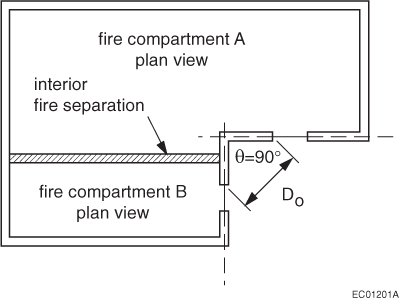
Figure A-3.2.3.14.(1)-A
Openings in walls at a right-angle corner

Figure A-3.2.3.14.(1)-B
Openings in walls that are parallel to one another
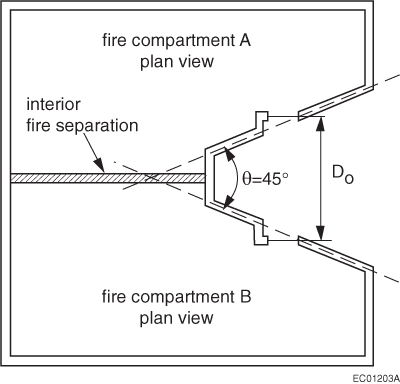
Figure A-3.2.3.14.(1)-C
Openings in walls with an included angle of 45°
A-3.2.4. Fire Alarm System
The
term “fire alarm system” used in this Subsection applies to fire alarm
systems with or without voice communication capability.
A-3.2.4.4.(1) Single Stage Fire Alarm System
This requirement, in combination with Article 3.2.4.22., is intended to allow for the provision of voice communication capability as an integral part of a single stage fire alarm system.
A-3.2.4.4.(2)(c) Fire Alarm Alert Signal
In a 2-stage fire alarm system described in Sentence 3.2.4.4.(2), the alert signal may be transmitted to audible signal devices in designated locations or to audible signal devices
throughout the building. If actuated, the second stage alarm signal
in a 2-stage fire alarm system may sound throughout all zones in the
building. All manual station key switches would typically initiate
the alarm signal.
Sentence 3.2.4.4.(2) also allows the implementation of a “zoned 2-stage” sequence of operation, whereby the alarm signal
sounds in the zone of key switch actuation (and perhaps in the adjacent
zones, which may be the storey above and the storey below) and the
alert signal sounds throughout the rest of the building. This sequencing
would be created automatically by the fire alarm control unit.
The key or special device referred to in Clause 3.2.4.4.(2)(c) should be immediately available to all persons on duty who have been given authority to sound an alarm signal.
A-3.2.4.4.(2) Two-Stage Fire Alarm System
Sentence 3.2.4.4.(2), in combination with Article 3.2.4.22., is intended to allow for the provision of voice communication capability as an integral part of a 2-stage fire alarm system.
 A-3.2.4.6.(1) Commissioning of Life Safety and Fire Protection Systems
A-3.2.4.6.(1) Commissioning of Life Safety and Fire Protection SystemsWhen commissioning a building, the owner must ensure that the life safety systems
and their components (i.e. fire alarm systems, sprinklers, standpipes, smoke
control, ventilation, pressurization, door hold-open devices, elevator recalls,
smoke and fire shutters and dampers, emergency power, emergency lighting, etc.) are
functioning according to the intent of their design. The commissioning provides the
documented confirmation that building systems satisfy the intent of the Code.
Ultimately, someone will have to ensure that the interconnected operation of all
life safety systems within the building has been confirmed: this responsibility may
fall on the designer, owner, contractor or a commissioning body. The British
Columbia Building Code does not specify who must fulfill this role as this is an
administrative issue.


A-3.2.4.7.(2) Access to Silencing Switches
This requirement is intended to prevent easy access to silencing switches. The
satisfactory operation of a fire alarm system to alert the occupants of a building
to an emergency is predicated on the assumption that the alarm signal will be
silenced only after responsible staff have verified that no emergency exists.
Details on the emergency procedures to be used in case of fire are contained in the
British Columbia Fire Code.

A-3.2.4.8.(4) Fire Department Notification
In some jurisdictions, the fire department may utilize, or have
available, a municipal fire alarm system or equipment intended for
receiving notification by means of a direct connection. If used, it
is expected that these systems and installations conform to the requirements
of Sentence (4) so as to achieve and provide a uniform and reliable level of service. It is also intended that
a proprietary central station as well as a fire brigade used by a
large corporation, university campus or similar site comply with Sentence (4).
A-3.2.4.8.(5)(b) Emergency Telephone Number
In many municipalities an emergency telephone number, for example
911, is used for all emergency services and it is preferable to post
that number.
A-3.2.4.9.(2) Fire Alarm Zones
Alarm initiating devices referred to in this Sentence include fire
detectors, waterflow switches and manual stations. If a room or space
in a building extends through more than one storey of the building,
as in the case of multi-level dwelling units and machinery rooms,
judgment must be exercised in the zoning and annunciation of the fire
detectors in that room or space. In general, the lowest storey on
which access is provided into the room or space should be indicated
on the annunciator to avoid unnecessary delays for the responding
firefighters. Consideration should also be given to the use of numbers
or letters on the annunciator that correspond to those used in the
building elevators.
A-3.2.4.10.(3)(f) Supervision for Fire Pumps
Specific electrical supervision for fire pumps is stated in NFPA 20, “Installation of Stationary Pumps for Fire Protection,” which is referenced in NFPA 13, “Installation of Sprinkler Systems.”
A-3.2.4.12.(1) Smoke Detector Location
In the design and installation of the smoke detection system,
consideration must be given to all features which could have a bearing
on the location and sensitivity of the detectors, including ceiling
height, sloped ceilings, diffusion from air conditioning and ventilating
currents, obstructions, baffles, and other pertinent physical configurations
that might interfere with the proper operation of the system.
A-3.2.4.12.(3) Visible Signals
If staff located in each zone or compartment can see each sleeping
room door, visible signals may be located above each door. If staff
cannot see every door, it is intended that the visible signals be
provided at the location where the staff are normally in attendance.
The audible signal is intended to alert staff of the need to check
the visible signals.
A-3.2.4.17.(1) Manual Station
Only one manual station need be provided near a group of doors serving as a
principal entrance or as a single exit facility.
Designated exits include required exits as well as other egress
facilities that have been designed and identified as exits (with all the features
as
if they were required exits).
Egress facilities that are provided for convenience and that do not include all the
features of required exits need not be provided with a manual pull station.

A-3.2.4.19. Acoustic Measurement and Terminology
The following notes on acoustic measurement and terminology are intended to assist
in the application of the requirements for audibility of fire alarm system sounding
devices.
The background or ambient measurement should be a spatial averaged A-weighted
equivalent sound level measured for 60 s. This can be obtained using an
integrating sound level meter with the integration time set to 60 s.
During the measurement period the meter should be slowly moved about so as to sample
the space uniformly but coming no closer than 0.5 m from any solid
wall, floor or ceiling. Alternatively, measurements can be made at 3 or more
positions throughout the space and an energy average calculated.
The measurement of the alarm level depends on the type of alarm signal. If the
signal is a continuous signal from a bell or siren, the spatial averaged A-weighted
equivalent sound level should be obtained. The integration time should be long
enough to obtain a reasonable spatial average of the space, but not less than
10 s.
If the alarm has a temporal pattern, then the A-weighted sound level should be
measured using the 'fast' time constant during the 'on' part of the cycle. In this
situation it is not appropriate to use an integrating sound level meter. Since the
duty cycle of the alarm is only 37.5% at best, that type of meter would give a
reading that is 4 or more decibels lower than the level while the alarm is 'on.' A
number of measurements should be made about the space in question and the average
value used to obtain a good spatial representation. Strictly speaking, the energy
average of the measurements should be used; however, the frequency spectrum
associated with most alarms is of a type that should give little variation about the
space. If the measured levels don't vary by more than 2 to 3 dB, then
an arithmetic average rather than an energy average can be used.
Effect of Furnishings
The final inspection of a fire alarm system is seldom made when the building is
furnished and ready for occupancy. This results in measured levels which may be
several decibels higher than will be found in the occupied building. The importance
of this difference depends on the situation.
If the building is complete except for furnishings, so that the sources of ambient
noise are present, then the amount by which the alarm signal exceeds the ambient
level will not change appreciably with the introduction of furnishings. In this case
both levels will be reduced by about the same amount.
If the primary source of ambient noise will be office equipment and workers, as
would be expected in an open plan office, then measurements made prior to occupancy
may differ substantially from those made afterwards. This may be true for both the
absolute sound levels and the difference between the alarm level and the
ambient.
A problem arises in trying to estimate what the absolute sound levels will be
after the building is occupied.
In general, if the measurement is made in a totally bare room then the level will
be about 3 dB higher than if the room were carpeted, assuming a
reasonable carpet with an underlay. In most cases this will account for most of the
absorption in the room and no further correction will be necessary. Adding heavy
drapes and absorptive furnishings to a carpeted room can reduce the sound level by
a
further 2 to 3 dB.
Commercial buildings are more problematic. For example, if an open plan office is
measured before any office screens are installed, there could be a substantial
difference in the before and after levels, depending on the distance to the nearest
alarm device.
Glossary of Acoustical Terms
Audible: A signal is usually considered to be clearly audible if the A-weighted
sound level exceeds the level of ambient noise by 15 dB or
more.
Awakening threshold: The level of sound that will awaken a sleeping subject 50% of
the time.
A-weighted: A frequency weighting network which emphasizes the middle frequency
components similar to the response of the human ear. The A-weighted sound level
correlates well with subjective assessment of the disturbing effects of sounds. The
quantity is expressed in dBA.
Masked threshold: The level of sound at which a signal is just audible in ambient
noise.
Sound level: A sound pressure level obtained using a signal to which a standard
frequency-weighting has been applied.
Sound pressure: A fluctuating pressure superimposed on the static pressure by the
presence of sound. The unqualified term means the root-mean-square sound pressure.
In air, the static pressure is barometric pressure.
Sound pressure level: Ten times the common logarithm of the ratio of the square of
the sound pressure under consideration to the square of the standard reference
pressure of 20 mPa. The quantity obtained is expressed in
decibels.
A-3.2.4.19.(1) Alert and Alarm Signals
Alert signals are part of a 2 stage fire alarm system. The
intent of the first, alert, stage is to notify persons in authority
of a potential threat to building occupants. If a continuously staffed
location is available, the alert signal can be restricted to that
location.
A-3.2.4.19.(2) Alarm Signal Temporal Pattern
The temporal pattern of an alarm signal relates to the time during which the
signal is produced and the intervals between the individual signal pulses. The
international standard ISO 8201, “Acoustics – Audible emergency evacuation signal,” includes a pattern that is becoming widely used in different countries and it is appropriate
for this pattern to be adopted in Canada. The temporal pattern can be produced on
most signalling devices. Most existing alarm systems can be modified, and this
pattern could be phased in when the systems require modification. The characteristic
of the pattern is a 3-pulse phase followed by an off phase. The 3 pulses each
consist of an on phase lasting for 0.5 ± 0.05 s followed by an off
phase lasting for 0.5 ± 0.05 s sounded for 3 successive on periods and
then followed by an off phase lasting for 1.5 ± 0.15 s. Figure A-3.2.4.19.(2)-A indicates the pattern
that is intended.
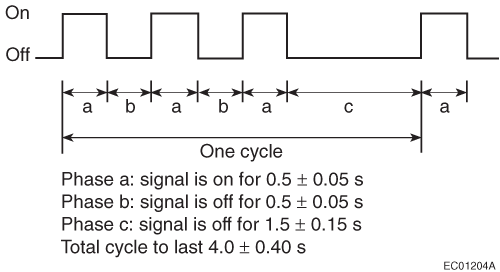
Figure A-3.2.4.19.(2)-A
Temporal pattern for fire alarm signal
Although the diagram shows a square wave form, the wave can have other shapes that
produce a similar effect.
If single stroke bells are to be used, the temporal pattern can be produced by
having the bell struck three times at a rate of one stroke per second followed by
an
interval of 2 s of silence. Figure A-3.2.4.19.(2)-B shows the pattern that results.

Figure A-3.2.4.19.(2)-B
Temporal pattern imposed on a single stroke bell or chime
Notes to Figure A-3.2.4.19.(2)-B:
A-3.2.4.19.(3) Audibility of Alarm Systems
It is very difficult to specify exactly what types of sound
patterns are considered to be “significantly different” from one another.
The intent is to ensure that there is a noticeable or measurable difference
between the alert signals and the alarm signals such that it reduces
the possibility of confusion.
A-3.2.4.19.(4) Sound Pressure Level
For the purposes of this requirement, an audible signalling device
should not produce a sound pressure level more than 110 dBA when measured at a distance of 3 m.
A-3.2.4.19.(5) Residential Sound Level
In a building in which corridors or hallways serve more than
one suite or dwelling unit, there will be situations in which an audible
signal device cannot be placed in the corridor or hallway to alert
persons sleeping in suites and dwelling units, because the sound level
in the vicinity of the device would exceed that permitted by Sentence 3.2.4.19.(4). In these situations it will be necessary to supplement the building fire alarm system with an audible signal device in the
suite or dwelling unit. These devices could be piezoelectric devices
similar to the sounding units in many smoke alarms, subject to the
device emitting the appropriate temporal pattern required by Sentence 3.2.4.19.(2).
A-3.2.4.19.(7) Disconnect Device for Dwelling Units
In order to minimize the annoyance caused by false
and unwanted alarms, the disconnect will permit a person to silence
the local audible device within the dwelling unit. At that time the
person would be aware of sounds from devices in common spaces and
could plan appropriate action. The disconnect will reduce the possibility
of tampering with the audible devices.
A-3.2.4.19.(8) Signal Circuits
Clause 3.2.4.19.(8)(a) permits Class A wiring, or Class B wiring with signal circuit isolators located outside of the suites, to serve audible signal devices within residential suites.
Clause 3.2.4.19.(8)(b) permits a separate signal circuit to serve each suite without the need for signal circuit isolators or Class A wiring.
Open circuits and Class A and Class B wiring circuits are terms defined in CAN/ULC-S524, “Installation of Fire Alarm Systems.”
A-3.2.4.20.(2) Visual Alarm Signal
CAN/ULC-S526, “Visible Signal Devices for Fire Alarm Systems, Including Accessories,” published by Underwriters' Laboratories of Canada, applies to visual signalling
units. This document is referenced by the most recent standard for
the installation of fire alarm systems and would automatically apply.
Current Canadian technology does not integrate visual and audible
alarms to have the same temporal pattern. Visual and audible alarms
should have as close a temporal pattern as possible but without interference
beats that might have a deleterious effect on some persons. Visual
signalling devices with the same temporal pattern as required for
audible devices are available from some sources and they should become
available in Canada. Not all units that comply with the ULC standard
will have sufficient power to adequately cover large areas; care will
have to be taken to specify units with adequate power when large spaces
are being designed.
A-3.2.4.21.(6)(a) Smoke Alarm Installation
The British Columbia Electrical Safety Regulation permits a smoke alarm to be installed
on most
residential circuits that carry lighting outlets and receptacles. It is the intent
of the British Columbia Building Code that any other item on a circuit with a smoke
alarm should be unlikely to be overloaded and trip the breaker with a resultant loss
of power that is not sufficiently annoying for the breaker to be restored to the on
position. It is considered that an interior bathroom light or a kitchen light
fulfills this intent, but that circuits restricted to receptacles do not fulfill
this intent.

 A-3.2.4.21.(7) Smoke Detectors in lieu of Smoke Alarms
A-3.2.4.21.(7) Smoke Detectors in lieu of Smoke AlarmsIt is intended that the smoke detector in this application will function as per the
requirements of a smoke alarm; specifically, it will be a localized alarm to that
suite. The advantage of this type of installation is that the detector would be monitored
by the fire alarm panel, which would provide notification to supervisory personnel
and be inspected as per CAN/ULC-S524, “Installation of Fire Alarm Systems.”

A-3.2.4.22.(1)(b) Voice Messages
The concept of intelligibility expressed in Clause 3.2.4.22.(1)(b) is intended to mean that a person with average hearing and cognitive abilities is able to understand the messages that are transmitted
into the space occupied by the person. There is no absolute measure
to predetermine the effect of loudspeakers and it may be necessary,
once the building has been furnished and occupied, to increase the
number of loudspeakers to improve the quality of the messages.
The intelligibility of the message depends on the speech level,
the background level, and the reverberation time of the space. ISO 7731, “Ergonomics – Danger signals for public and work areas – Auditory danger signals,” addresses audibility. The standard suggests
that an A-weighted sound level at least 15 dBA above
the ambient is required for audibility, but allows for more precise
calculations using octave or 1/3 octave band frequencies to tailor
the alarm signal for particular ambient noise conditions. Design of
the alarm system is limited to ensuring that all areas receive an
adequately loud alarm signal.
If a public address system is to be used to convey instructions
during an emergency, then the requirements of the system are less
straightforward. In general, however, a larger number of speakers
operating at lower sound levels would be required.
 A-3.2.4.22.(2) Voice Intelligibility
A-3.2.4.22.(2) Voice IntelligibilityCommon intelligibility scale measuring requirements and guidance
on the proper design of intelligible voice and alarm systems can be
found in Annex A.7.4.1.4 of NFPA 72, “National Fire Alarm and Signaling Code.”

A-3.2.5.4.(1) Fire Department Access for Detention Buildings
Buildings of Group B, Division 1 used for housing
persons who are under restraint include security measures that would
prevent normal access by local fire departments. These security measures
include fencing around the building site, exterior walls without openings
or openings which are either very small or fitted with bars, and doors
that are equipped with security hardware that would prevent easy entry.
These buildings would have firefighting equipment installed and the
staff would be trained to handle any small incipient fires. It is
expected that appropriate fire safety planning would be undertaken
in conjunction with local fire departments in order that special emergencies
could be handled in a cooperative manner.
A-3.2.5.6.(1) Fire Department Access Route
The design and construction of fire department access routes involves the
consideration of many variables, some of which are specified in the requirements in
the Code. All these variables should be considered in relation to the type and size
of fire department vehicles available in the municipality or area where the building
will be constructed. It is appropriate, therefore, that the local fire department
be
consulted prior to the design and construction of access routes.
A-3.2.5.7.(1) Water Supply
The intent of Sentence 3.2.5.7.(1) is that an adequate water supply for firefighting be readily available and of sufficient volume and pressure
to enable emergency response personnel to control fire growth so as to enable the
safe evacuation of occupants and the conduct of search and rescue operations,
prevent the fire from spreading to adjacent buildings, and provide a limited measure
of property protection.
The water supply requirements for buildings containing internal fire suppression
systems, including sprinkler systems and standpipe systems, are contained in
specific standards referenced in the Code. Compliance with the referenced standard,
including any variations made by this Code,  is deemed to satisfy the intent of Sentence 3.2.5.7.(1)
is deemed to satisfy the intent of Sentence 3.2.5.7.(1) . However, it will be necessary to verify that an adequate source of water is available at the building
site to meet the required quantities and pressures.
. However, it will be necessary to verify that an adequate source of water is available at the building
site to meet the required quantities and pressures.
 is deemed to satisfy the intent of Sentence 3.2.5.7.(1)
is deemed to satisfy the intent of Sentence 3.2.5.7.(1) . However, it will be necessary to verify that an adequate source of water is available at the building
site to meet the required quantities and pressures.
. However, it will be necessary to verify that an adequate source of water is available at the building
site to meet the required quantities and pressures.
For a building with no internal fire suppression system, the determination of the
minimum requirements applicable to the water supply for firefighting is relevant
mainly to building sites not serviced by municipal water supply systems. For
building sites serviced by municipal water supply systems, where the water supply
duration is not a concern, water supply flow rates at minimum pressures is the main
focus of this provision. However, where municipal water supply capacities are
limited, it may be necessary for buildings to have supplemental water supplies on
site or readily available.
The sources of water supply for firefighting purposes may be natural or developed.
Natural sources may include ponds, lakes, rivers, streams, bays, creeks, and
springs. Developed sources may include aboveground tanks, elevated gravity tanks,
cisterns, swimming pools, wells, reservoirs, aqueducts, artesian wells, tankers,
hydrants served by a public or private water system, and canals. Consideration
should be given to ensuring that water sources will be accessible to fire department
equipment under all climatic conditions.
The volume of on-site water supply is dependent on the building size,
construction, occupancy, exposure and environmental impact potential, and should be
sufficient to allow at least 30 minutes of fire department hose stream
use.
For the purposes of calculating adequate water supply requirements for fire
fighting the following documents may be useful:
- Insurance Services Office (ISO), “Needed Fire Flow Guide”
 NFPA 1142, “Standard on Water Supplies for Suburban and Rural Fire Fighting,”
NFPA 1142, “Standard on Water Supplies for Suburban and Rural Fire Fighting,” and
and - American Water Works Association “Distribution Requirements for Fire Protection.”

A-3.2.5.9.(5)(c) Fire Department Pumping Equipment
Availability of appropriate pumping equipment from the local
fire department or, in the case of industrial plants or complexes,
from their fire brigade, is considered sufficient to meet the intent
of this requirement.
A-3.2.5.11.(2) Hose Stations
A
building that is partially sprinklered may have some floor areas where
local sprinklers are installed that do not cover the entire floor
area. It is intended that hose stations be provided in these floor
areas to allow emergency responders to fight fires that cannot be
controlled by local sprinklers.
A-3.2.5.12.(1) Sprinkler System Design
In NFPA 13, “Installation of Sprinkler Systems,” reference is made to other NFPA standards that contain additional sprinkler design criteria. These criteria apply to industrial occupancies with high fire loads and
industrial occupancies intended for the use, manufacture or storage of highly flammable
materials. Therefore, while only NFPA 13 is called up directly by Sentence 3.2.5.12.(1), the additional criteria in the other NFPA standards are included automatically.
In some NFPA standards, certain aspects of sprinkler protection are dependent on the
fire-resistance rating of the vertical structural members. In these cases, the sprinkler
system design options can be affected by the fire-resistance rating of these elements.
For example, in buildings used for the storage of rubber tires, sprinklers directed
at the sides of a column are required if the column does not have the required fire-resistance
rating.
Other NFPA standards may require that certain occupancies be sprinklered in conformance
with NFPA 13, as in the case of some garages. These requirements do not supersede the requirements in the Code. An occupancy is required to be sprinklered only when this is specified
in the Code, but when it is so required, it must be sprinklered in conformance with
NFPA 13 and its referenced standards.
A-3.2.5.12.(6) Sprinklering of Roof Assemblies
Sprinkler protection for roof assemblies in lieu of fire resistance is based on the
assumption that the sprinklers will protect the roof assembly from the effects of
fire in spaces below the roof. If a ceiling membrane is installed, the sprinklers
would have to be located below the membrane in order to react quickly to the fire.
In certain instances, however, sprinklers may be required within the concealed spaces
as well as below the membrane. NFPA 13, “Installation of Sprinkler Systems,” requires sprinklers in certain concealed spaces.
According to NFPA 13 and 13R,  some small rooms and closets within a dwelling unit in a sprinklered building, including those that may be in
some small rooms and closets within a dwelling unit in a sprinklered building, including those that may be in the storey immediately below the roof assembly, do not require sprinklers. However, the NBC requires sprinkler protection within all rooms and closets immediately below
the roof so as to control any fire that might start in that space and thereby limit
the probability of the fire spreading into the roof assembly.
the storey immediately below the roof assembly, do not require sprinklers. However, the NBC requires sprinkler protection within all rooms and closets immediately below
the roof so as to control any fire that might start in that space and thereby limit
the probability of the fire spreading into the roof assembly.
 some small rooms and closets within a dwelling unit in a sprinklered building, including those that may be in
some small rooms and closets within a dwelling unit in a sprinklered building, including those that may be in the storey immediately below the roof assembly, do not require sprinklers. However, the NBC requires sprinkler protection within all rooms and closets immediately below
the roof so as to control any fire that might start in that space and thereby limit
the probability of the fire spreading into the roof assembly.
the storey immediately below the roof assembly, do not require sprinklers. However, the NBC requires sprinkler protection within all rooms and closets immediately below
the roof so as to control any fire that might start in that space and thereby limit
the probability of the fire spreading into the roof assembly.
Moreover, NFPA 13D, “Installation of Sprinkler Systems in One- and Two-Family Dwellings and Manufactured Homes,” also allows the omission of sprinklers in such rooms and closets under certain circumstances,
provided the building is sprinklered in conformance with this standard. In this case,
the NBC concurs with the provisions of the NFPA 13D standard.
A-3.2.5.12.(7) Fast-Response Sprinklers
Several types of sprinkler will respond to a fire faster than a conventional standard
response sprinkler. The Response Time Index (RTI) is used to quantify the sensitivity
of the sprinkler link for any given sprinkler. The RTI for the group of fast-response
sprinklers described below will on average range from 22 s0.5•m0.5 to 33 s0.5•m0.5. RTI values for standard response sprinklers will typically be in the range of 83 s0.5•m0.5 to 110 s0.5•m0.5.
Any confusion as to the appropriate type of fast-response sprinkler for different
types of building should be alleviated by considering the testing criteria described
below and the reference to the appropriate NFPA installation standards.
Although the Code specifies where fast response sprinklers are required it does not
prevent the appropriate use of fast-response sprinklers in other occupancies.
Residential sprinklers are tested in accordance with ANSI/UL-1626, “Residential Sprinklers
for Fire-Protection Service.” They are installed in accordance with NFPA 13R, “Standard for the Installation of Sprinkler Systems in Low-Rise Residential
Occupancies,” with NFPA 13D, “Installation of Sprinkler Systems in One- and Two-Family
Dwellings and Manufactured Homes.” and with Section 5-4.5 of NFPA 13, “Installation of Sprinkler Systems,” for residential occupancies and for dwelling units.
Quick-response sprinklers are tested in accordance with ANSI/UL-199, “Automatic Sprinklers
for Fire-Protection Service.” They are installed in accordance with NFPA 13, “Installation of Sprinkler Systems,” for spacing, density and location. They are acceptable for limited use as described
in NFPA 13R, “Standard for the Installation of Sprinkler Systems in Low-Rise Residential
Occupancies,” but are not permitted for use under NFPA 13D, “Installation of Sprinkler Systems in One- and Two-Family
Dwellings and Manufactured Homes.”
Early suppression fast-response sprinklers are tested in accordance with FM 2008,
“Early Suppression - Fast-Response Sprinklers.” They are installed in accordance with
NFPA 13, “Installation of Sprinkler Systems,” but are not accepted for use under either NFPA 13R, “Standard for the Installation of Sprinkler Systems in Low-Rise Residential
Occupancies,” or NFPA 13D, “Installation of Sprinkler Systems in One- and Two-Family
Dwellings and Manufactured Homes.”
Quick response extended coverage sprinklers are tested in accordance with ANSI/UL
199, “Automatic Sprinklers for Fire-Protection Service.” They are installed in accordance
with NFPA 13, “Installation of Sprinkler Systems,” for spacing, density and location. They are acceptable for limited use as permitted
by NFPA 13R, “Standard for the Installation of Sprinkler Systems in Low-Rise Residential
Occupancies,” but are not permitted for use under NFPA 13D, “Installation of Sprinkler Systems in One- and Two-Family
Dwellings and Manufactured Homes.”
A-3.2.5.12.(8) Sprinkler Rating
The requirements of this Sentence can be met by using sprinklers with a rating of
79°C to 107°C.

A-3.2.5.13.(1) Hazard Classification for Sprinkler Selection
The reference to light hazard occupancies is based on the descriptions of these occupancies
given in NFPA 13, “Installation of Sprinkler Systems,” and is intended only for use in the design of sprinkler systems. These descriptions should not be confused with the occupancy classifications in the Code.
In NFPA 13, a light hazard occupancy is one in which the quantity or combustibility of contents is low and fires with relatively low rates of heat release are expected. Typical buildings
or parts of buildings include: churches; clubs; eaves and overhangs, if of combustible
construction with no combustibles beneath; educational buildings; hospitals; institutional
buildings; libraries, except very large stack rooms; museums; nursing or convalescent
homes; offices, including data processing rooms; residential buildings; restaurant
seating areas; theatres and auditoria, excluding stages and proscenia; and unused
attics.
Although NFPA 13R, “Standard for the Installation of Sprinkler Systems in Low-Rise Residential Occupancies,” and NFPA 13D, “Installation of Sprinkler Systems in One- and Two-Family Dwellings and Manufactured Homes,” as referenced by NFPA 13, are concerned with specific types of residential occupancy, namely apartment buildings up to four storeys, one and two family dwellings, and mobile homes, for the purpose
of acceptance of combustible sprinkler piping these occupancies are considered to
be included in the category of residential buildings under light hazard occupancies.
A-3.2.5.18.(1) Fire Pumps
In order
to ensure an adequate water supply, it may be necessary to install
a fire pump for a building that has either a standpipe system or an
automatic sprinkler system installed.
A-3.2.7.4.(1) Emergency Power Reliability
In some areas power outages are frequent and may be of long
duration. These local conditions should be taken into account in determining
the type of system for supplying emergency power for lighting. This
should be studied at the planning stage of a building project in conjunction
with the local fire safety and building officials.
A-3.2.7.6.(1) Emergency Power for  Treatment Occupancies
Treatment Occupancies
 Treatment Occupancies
Treatment Occupancies
CSA Z32, “Electrical Safety and Essential Electrical Systems in Health Care Facilities,” contains requirements for three classes of health care facilities—Class A, Class
B and Class C.  The intent of Article 3.2.7.6. is to apply specific requirements to emergency equipment for Class A facilities, which are designated as hospitals by the authorities having jurisdiction and where
patients are accommodated on the basis of medical need and are provided with continuing
medical care and supporting diagnostic and therapeutic services.
The intent of Article 3.2.7.6. is to apply specific requirements to emergency equipment for Class A facilities, which are designated as hospitals by the authorities having jurisdiction and where
patients are accommodated on the basis of medical need and are provided with continuing
medical care and supporting diagnostic and therapeutic services.
 The intent of Article 3.2.7.6. is to apply specific requirements to emergency equipment for Class A facilities, which are designated as hospitals by the authorities having jurisdiction and where
patients are accommodated on the basis of medical need and are provided with continuing
medical care and supporting diagnostic and therapeutic services.
The intent of Article 3.2.7.6. is to apply specific requirements to emergency equipment for Class A facilities, which are designated as hospitals by the authorities having jurisdiction and where
patients are accommodated on the basis of medical need and are provided with continuing
medical care and supporting diagnostic and therapeutic services.
A-3.2.7.8.(3) Emergency Power Duration
The times indicated in this Sentence are the durations for which emergency power
must be available for a building under fire emergency conditions. Additional fuel
for generators or additional battery capacity is required to handle normal testing
of the equipment, as indicated in the British Columbia Fire Code. If the operation
of emergency generators or batteries is intended for other than fire emergency
conditions, such as power failures, fuel supplies or battery capacity must be
increased to compensate for that use.

A-3.2.7.9.(1) Emergency Power Reliability
In some areas power outages are frequent and may be of long
duration. These local conditions should be taken into account in determining
the type of system for supplying emergency power for building services.
This should be studied at the planning stage of a building project
in conjunction with the local fire safety and building officials.
 A-3.2.7.10.(5)(b) Electrical Conductors in the Same Room
A-3.2.7.10.(5)(b) Electrical Conductors in the Same RoomIf the distribution panel and the equipment
it serves are within the same room, only the electrical conductors
leading up to the distribution panel need to be protected. It is assumed
that the distribution panel and the equipment it serves are within
sufficient proximity to each other such that a fire in the same area
of origin would affect both.
A-3.2.7.10.(7) Fire Alarm Branch Circuits
In order to ensure continuous operation of the fire alarm and
voice communication systems in a high-rise building for a sufficient
duration of time to control and direct the evacuation of building
occupants, a level of protection is required by Sentence 3.2.7.10.(2) for those electrical conductors interconnecting the major elements of the fire alarm system. Sentence 3.2.7.10.(7) permits the protection of electrical conductors to be waived for portions connecting
a transponder or fault isolation device to fire alarm input devices
(fire detectors, manual stations, etc.) or a voice communication transponder
to a fire alarm audible signalling device, provided all circuits or
portions of the circuits are contained within the same storey.

A-3.2.8.2.(3) Special Protection of Opening
In manufacturing operations involving the use of conveyor systems to transport material
through fire separations, it may not be possible to use standard closure devices.
NFPA 80, “Fire Doors and Other Opening Protectives,” includes appendix information concerning protection of openings through vertical fire separations. NFPA 13, “Installation of Sprinkler Systems,” includes methods of protecting openings through floor assemblies, however, it is assumed by that standard that the remainder of the building would be sprinklered.
Combinations of methods may be required to ensure that the level of safety inherent
in the requirements of the Code is maintained.
A-3.2.8.2.(6)(b) Stairway Opening
The phrase “used only for stairways, escalators or moving walks”
is intended to restrict a floor opening to the size that is necessary
to accommodate the stairway, escalator or moving walk.
A-3.2.8.2.(6)(c) Waiver of Occupancy Separation Continuity
The typical application of this Sentence is
to buildings with a mixture of occupancies that are randomly located
throughout the building. Examples include shopping centres, podia
of large commercial and business complexes, and recreational buildings
that are combined with mercantile and business operations. A shopping
mall with two interconnected storeys is an example that is frequently
encountered in many jurisdictions. The permission to breach the floor
assembly between the storeys does not override requirements for separation
of specific suites or occupancies. For instance, although storage
garages are Group F, Division 3 occupancies, the requirement in Article 3.3.5.6. for the storage garage to be separated from other occupancies by a fire separation with at least a 1.5 h fire-resistance rating must be observed. In a similar manner, a
theatre or cinema (Group A, Division 1 occupancy) must be separated
from other occupancies in accordance with Sentence 3.3.2.2.(1) and seats in an arena-type building (Group A, Division 3) must be separated from space below in accordance with Sentence 3.3.2.2.(3).
 A-3.2.8.5.(1)(c) Contamination of Vestibule
A-3.2.8.5.(1)(c) Contamination of VestibuleThe vestibule should have equipment capable of maintaining a supply of air into
the vestibule that is sufficient to ensure that the air pressure in the vestibule
when the doors are closed is higher by at least 12 Pa than the air
pressure in the adjacent floor areas when the outdoor temperature is equal to the
January design temperature on a 2.5% basis.

A-3.2.8.8.(1) Smoke Exhaust System
The mechanical exhaust system is intended as an aid to firefighters
in removing smoke and is to be designed to be actuated manually by
the responding fire department. Although smoke is normally removed
from the top of the interconnected floor space, exhaust outlets at
other locations may be satisfactory.
A-3.3. Safety Within Floor Areas
Section 3.3. regulates safety within floor areas including rooms and
other spaces within a building, with the exception of service rooms and service
spaces, which are regulated by Section 3.6. The requirements are grouped
according to the occupancy of the floor area, room or space, which is not
necessarily the same as the major occupancy for which the building is classified.
For example, a building may be classified by major occupancy as an office building:
therefore, the provisions for structural fire protection and fire protection
equipment for office buildings prescribed in Section 3.2. apply.
However, within that building, a room or floor area may be used for mercantile,
care,  treatment
treatment , detention, business, residential, industrial or other occupancy.
, detention, business, residential, industrial or other occupancy.
 treatment
treatment , detention, business, residential, industrial or other occupancy.
, detention, business, residential, industrial or other occupancy.
Life safety for the occupants of any floor area depends in the first instance on
the use or occupancy of that floor area. The risks to the occupants occur in the
early stages of a fire. These special life risks differ from one occupancy to
another and, consequently, must be regulated differently. Section 3.3. regulates risks within floor areas: these requirements
apply regardless of the major occupancy of the building that contains the floor
areas. For example, an assembly room must comply with the requirements for assembly
occupancy whether it is contained in an office building, hospital, hotel, theatre,
industrial building or other major occupancy.
Since this Code regulates new construction, alterations and changes of occupancy,
the construction of kiosks and similar structures in public corridors must take into
consideration all the requirements that apply to the remainder of the building,
including structural fire protection, construction type, finish materials, egress
widths and sprinkler installations. Special activities of an occasional nature that
were not contemplated in the original design of a public corridor and that represent
only a temporary change in occupancy are regulated by the British Columbia Fire
Code. These regulations include maintaining egress paths clear of obstructions,
controlling combustible contents and providing measures to ensure quick response for
firefighting.

A-3.3.1.2.(1) Hazardous Substances
Dangerous goods, as defined in the British Columbia Fire Code and regulated by
TC SOR/2008-34, “Transportation of Dangerous Goods Regulations (TDGR),” constitute one type of hazardous substance in the sense of the British Columbia
Building Code. They include gases and radioactive, corrosive, poisonous, oxidizing,
reactive, explosive and flammable substances. The term “hazardous substance” in the
British Columbia Building Code also means materials and products that are not
regulated by the Transportation of Dangerous Goods Regulations but that pose a fire
or explosion hazard due to their own properties or because of the manner in which
they are stored, handled or used. These include combustible products, rubber tires,
combustible fibres, combustible dusts, products producing flammable vapours or
gases, etc.

A-3.3.1.2.(2) Cooking Equipment Ventilation
Cooking equipment manufactured for use in dwelling units and other residential suites
is often installed in buildings used for assembly and care,  treatment
treatment or detention purposes. It is not obvious from the Code requirements or those of NFPA 96, “Ventilation Control and Fire Protection of Commercial Cooking Operations,” whether a ventilation and grease removal system is required in all assembly and care,
or detention purposes. It is not obvious from the Code requirements or those of NFPA 96, “Ventilation Control and Fire Protection of Commercial Cooking Operations,” whether a ventilation and grease removal system is required in all assembly and care,  treatment
treatment or detention uses. If the equipment is to be used in a manner that will produce grease-laden vapours that are substantially more than would be produced in a normal household environment,
then it would be appropriate to apply the requirements of NFPA 96. If the equipment is used primarily for reheating food prepared elsewhere or is used occasionally for demonstration or educational purposes, there would be no expectation
of applying the requirements of NFPA 96. In all cases the circumstances should be reviewed with the authority having jurisdiction.
or detention uses. If the equipment is to be used in a manner that will produce grease-laden vapours that are substantially more than would be produced in a normal household environment,
then it would be appropriate to apply the requirements of NFPA 96. If the equipment is used primarily for reheating food prepared elsewhere or is used occasionally for demonstration or educational purposes, there would be no expectation
of applying the requirements of NFPA 96. In all cases the circumstances should be reviewed with the authority having jurisdiction.
 treatment
treatment or detention purposes. It is not obvious from the Code requirements or those of NFPA 96, “Ventilation Control and Fire Protection of Commercial Cooking Operations,” whether a ventilation and grease removal system is required in all assembly and care,
or detention purposes. It is not obvious from the Code requirements or those of NFPA 96, “Ventilation Control and Fire Protection of Commercial Cooking Operations,” whether a ventilation and grease removal system is required in all assembly and care,  treatment
treatment or detention uses. If the equipment is to be used in a manner that will produce grease-laden vapours that are substantially more than would be produced in a normal household environment,
then it would be appropriate to apply the requirements of NFPA 96. If the equipment is used primarily for reheating food prepared elsewhere or is used occasionally for demonstration or educational purposes, there would be no expectation
of applying the requirements of NFPA 96. In all cases the circumstances should be reviewed with the authority having jurisdiction.
or detention uses. If the equipment is to be used in a manner that will produce grease-laden vapours that are substantially more than would be produced in a normal household environment,
then it would be appropriate to apply the requirements of NFPA 96. If the equipment is used primarily for reheating food prepared elsewhere or is used occasionally for demonstration or educational purposes, there would be no expectation
of applying the requirements of NFPA 96. In all cases the circumstances should be reviewed with the authority having jurisdiction. A-3.3.1.7.(1) BC Deleted

A-3.3.1.9.(4) Obstruction in Corridor
The sweep of a cane used by blind or visually impaired persons
normally detects obstructions that are within 680 mm of
the floor. Any obstruction above this height would not normally be
detected and can, therefore, create a hazard if it projects more than 100 mm into the path of travel.
A-3.3.1.12.(3) Movable Partitions
Should an emergency situation arise outside of normal working hours
but when occupants are still in the space, they could be left without
a clear way out. This could occur during inventory or after closing
time when all occupants have not yet left, but staff close the door
to prevent other persons from entering. In many small tenant areas,
the movable partitions (store fronts) provide the only way out. There
should always be a second way out or a swinging door within or adjacent
to the sliding partitions.
A-3.3.1.13.(4) Door Hardware
The
permission to have additional door releasing devices is intended to
allow the use of a security chain, night latch or dead bolt to supplement
the normal door latching device. These are permitted for dwelling
units and locations where guests in a hotel or motel require additional
security. The height of these items is also governed by the maximum
height stipulated in Sentence 3.3.1.13.(5) to ensure that they can be operated by persons with physical disabilities. This additional
hardware should not require appreciable dexterity by the user and
the general requirements on the ability to operate the device without
the use of keys, special tools or specialized knowledge still apply.
A-3.3.1.13.(6) Controlled Egress Doors
It is intended that Sentence 3.3.1.13.(6) apply to doors used at the perimeter of a contained use area or an impeded egress
zone. If the contained use area consists of a single room, the requirements
would apply to that room. In the case of individual cells within a
contained use area, exterior keyed locks could be used on the cell
doors consistent with the fire safety plan and continuous supervision
by staff who can release the doors in an emergency.
A-3.3.1.13.(10)(a) Doorway Width
Standard wheelchair width specifications indicate a range of sizes from 584
mm overall to 685 mm overall. Every doorway that is located
in an accessible path of travel must have a clear width of not less than 800
mm when the door is in the open position and therefore it is important
that this dimension be measured correctly. Figure A-3.3.1.12.(10)(a) shows a door
opened to 90°. It is clear that the door, and to a lesser extent the
stop, impinges on the space within the door frame. The clear width of not less than
800 mm is measured from the face of the door to the outside edge of
the stop on the door frame. It is not sufficient just to measure the inside width
of
the door frame. Other factors, including location of door stops other than on the
door frame, and the installation of door closers and exit devices, should be taken
into account. The intrusion of a door handle into the space is of lesser importance.
It is recognized that there are many types of door frame and door mounts but the
overall objective is to maintain a clear width of not less than 800 mm.
The diagram depicts a somewhat restrictive scenario, as many doors can open wider
than 90°, however, a door smaller than 864 mm would not be
wide enough to ensure the minimum clear width of 800 mm that is
required.
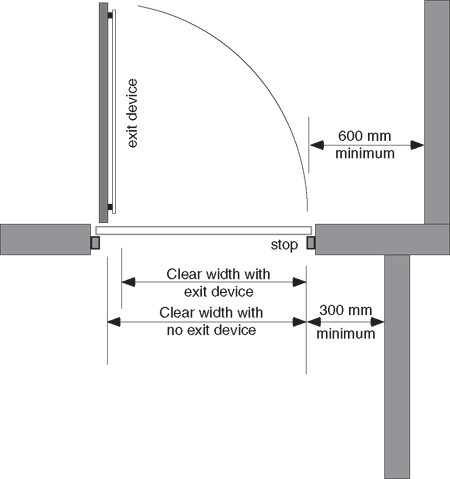
Figure A-3.3.1.13.(10)(a)-A
Clear doorway width
A-3.3.1.13.(10)(c) Lever Handles
Lever handles are usable by most persons with limited hand mobility and will meet
the intent of this requirement. Lever handles with an end return towards the door
are less prone to catch the clothing of someone passing through the doorway.
A-3.3.1.13.(10)(d) Air Pressure Differences
Differences in air pressure on opposite sides of a door may be due to the
operation of mechanical systems such as those associated with smoke control.
So-called "stack action" in buildings in winter can also cause differential
pressures due to the buoyancy of warm air. Stack action is usually most noticeable
between stairwells and the remainder of the building, and at the entrances to
buildings; the taller the building, the greater the effect. Doors with automatic
closers have to operate with sufficient opening force to allow the return action to
overcome the differential pressure.
A-3.3.1.13.(10)(e) Delayed Action on Door Closers
In some circumstances, closers with a delay feature which keeps the door open for
several seconds before it begins to close might be desirable. However, closers with
this feature have limited back-check, a feature of a normal door closer where
resistance to opening increases as the door reaches the full arc of swing. Doors
equipped with a delayed action closer are therefore more susceptible to damage
should the door be opened with too much force or should someone try to force it
closed, thinking the closer has failed to operate. Delayed action closers are not
recommended for such occupancies as schools.
A-3.3.1.23.(1) Obstructions in Means of Egress
Obstructions including posts, counters or turnstiles should
not be located in a manner that would restrict the width of a normal
means of egress from a floor area or part of a floor area unless an
alternative means of egress is provided adjacent to and plainly visible
from the restricted means of egress.
 A-3.3.2.1.(2) Use of NFPA 101
A-3.3.2.1.(2) Use of NFPA 101The intention of Sentence (2) is to allow Code users the option of using NFPA 101, “Life Safety Code,” to address the following issues: means of egress; egress routes within assembly occupancies; aisles and access serving seating not at tables; guards and railings; life safety
evaluation; and smoke-protected assembly seating. However, opting to use NFPA 101 under this application entails adherence to all the provisions listed in Sentence (2): it is not intended that Code users randomly select and apply a mix of provisions from both the British Columbia Building Code and the NFPA.


A-3.3.2.4.(2) Tablet Arms
Although
it is intended that the motion to raise the tablet arm be essentially
a single fluid motion, it is acceptable that the motion be a compound
motion of raising the tablet arm and including an articulation to
allow the tablet to fall back alongside the arm rest.
 A-3.3.2.16. Daycare Facilities with Children under 30 Months
A-3.3.2.16. Daycare Facilities with Children under 30 MonthsThese daycare facilities are subject to additional requirements to address the unique
profile of the occupants. (See also A-3.1.2.8.)

A-3.3.3.1.(1) Safety in Care, Treatment and Detention Occupancies
Fire safety for patients in bedroom areas in hospitals and nursing homes with
treatment is predicated on the ability of staff to carry out at all times essential
life safety functions in accordance with the fire safety plan. Details for a plan
are contained in the British Columbia Fire Code.
Many factors may affect the ability of staff to carry out life safety functions,
including the mobility of patients who cannot fend for themselves and the built-in
protection for patients who cannot be moved except under exceptional
circumstances.
Should a patient area in a hospital or nursing home with treatment contain factors
which would increase the time normally required for staff to evacuate patients or
to
undertake other life safety measures, consideration should be given to providing
additional fire protection measures to ensure that equivalent safety is
available.

A-3.3.3.4.(2) Doorway Width
The 1 050 mm minimum clear width of doorways accounts for door
stops and, thus, is intended to allow for the use of 1 100 mm doors.
A-3.3.3.5.(6) Weatherstripping
“Weatherstripped or otherwise” is intended to provide for adequate
draft resistant sealing material to retard the passage of smoke through
closure assemblies used in fire separations.
A-3.3.3.5.(10) Intercommunicating Rooms
Rooms that are interconnected can include more than one sleeping
room, together with ensuite toilet rooms, shower rooms, and storage
closets used for the storage of personal items of the persons occupying
the sleeping rooms. It is not intended that storage rooms for other
purposes be included within the group of interconnected rooms.
A-3.3.3.5.(14) Grilles and Louvres
In order to permit the supply of make-up air to compensate for the
removal of exhaust air from these toilet rooms, shower rooms and similar
spaces, it is permitted to incorporate grilles and louvres for the
transfer of air provided the air movement cannot allow smoke to pass
through these spaces to other parts of the building. It is considered
that in normal designs the air is exhausted directly to the exterior
and is not circulated. If air is to be circulated back to other parts
of the building, smoke operated dampers should be included in the
air circulating system.
A-3.3.4.4.(1) Landing in Egress Stairway
A landing level used in an egress stairway from a dwelling
unit is not considered to be a storey of that dwelling unit if the
landing is used only for pedestrian travel purposes.
A-3.3.4.5.(1) Automatic Locking Prohibited
Doors that must be manually reset to lock them when they are
opened from the inside meet the intent of this requirement.
 A-3.3.6.1.(1) Design of Buildings Containing Dangerous Goods
A-3.3.6.1.(1) Design of Buildings Containing Dangerous GoodsSubsection 3.3.6. applies to the short- or long-term storage of products,
whether raw or waste materials, goods in process, or finished goods.
This Subsection does not deal with products or materials that are directly
supplied to appliances, equipment or apparatus through piping, hose, ducts, etc. For
example, the gas cylinders that are mounted on propane barbecues are not covered by
Subsection 3.3.6.; they are considered to be “in
use” as opposed to “in storage” and are not intended to be regulated by the storage
requirements stated in the British Columbia Fire Code.

A-3.3.6.2.(2) Storage of Reactive Substances
Reactive substances may include various classes of unstable
or reactive dangerous goods, such as Class 4 flammable solids, Class
5 oxidizing substances or unstable Class 2 gases.
When containers of highly reactive oxidizers become damaged
or are exposed to excessive heat, moisture or contamination (e.g.
sawdust, petroleum products, or other chemicals), a very violent fire
or explosion can result. In some cases, depending on the quantity
and nature of the oxidizing agent, normal firefighting measures (e.g.
sprinklers, fire hose and extinguishers) are ineffective due to the
self-yielding of oxygen by the oxidizing agent.
In general, it is unsafe to store highly reactive oxidizers
close to liquids with low flash points, combustible products or chemically
incompatible products. Quantities of oxidizers should therefore be
limited and the storage area should be constructed of noncombustible
materials, should be kept cool and ventilated, and should not impede
egress.
The following classes of oxidizing substances are noted for
their ability to supply oxygen (this list is not meant to be all inclusive):
organic and inorganic peroxides; pool chemicals (e.g. calcium hypochlorite
and sodium dichloroisocyanurate); oxides; permanganates; perrhenates;
chlorates; perchlorates; persulfates; organic and inorganic nitrates;
bromates; iodates; periodates; perselenates; chromates, dichromates;
ozone; perborates.
A-3.3.6.2.(4) BC Deleted

A-3.3.6.4.(2) Explosion Venting in Hazardous Locations
When a flammable mixture of air and vapour/gas/dust
is ignited and causes an explosion, the exothermic reaction results
in the rapid expansion of heated gases and the corresponding pressure
waves travel through the mixture at sonic or supersonic velocities.
The pressures developed by an explosion very rapidly reach levels
that most buildings and equipment cannot withstand unless specifically
designed to do so. Explosion venting consists of devices designed
to open at a predetermined pressure to relieve internal pressure build-up
inside a room or enclosure, hence limiting the structural and mechanical
damage.
The major parameters to be considered in designing an explosion
venting system for a building are:
- the physical and chemical properties of the flammable air mixture, such as the particle size or the droplet diameter, the moisture content, the minimum ignition temperature and explosive concentration, the burning velocity or explosibility classification, the maximum explosion pressure and the rate of pressure rise,
- the concentration and dispersion of the flammable mixture in the room,
- the turbulence and physical obstructions in the room,
- the size and shape of the room, the type of construction and its ability to withstand internal pressures, and
- the type, size and location of relief panels, which should also be designed to reduce the possibility of injury to people in the immediate vicinity of the panels.
A-3.3.6.5.(1) Measurement of Tire Storage Volume
The volume of tires in a storage area can be determined by measuring
to the nearest 0.1 m the length, width and height of
the piles or racks intended to contain the tires. In racks, the top
shelf is assumed to be loaded to maximum possible height, while observing
required clearances between structural elements and sprinklers.
A-3.3.6.6.(6) Products Stored with Ammonium Nitrate
Copper and its alloys should not be used where
they can come into contact with ammonium nitrate. The presence of
copper represents the single biggest hazard with respect to the accidental
detonation of ammonium nitrate during a fire.
Steel and wood can be protected with special coatings such as
sodium silicate, epoxy, or polyvinyl chloride.
Asphalt and similar hydrocarbon-based roof coverings should
not be used. Stored ammonium nitrate may become sensitized during
a fire if such roof coverings melt and leak into the interior of the
building, causing burning droplets to fall on the stored product.

A-3.4.1.1.(1) Type of Exit Facility
The requirements for exits in Section 3.4. were
developed for new construction. If alterations are made to an existing
building or changes of occupancy occur, other design solutions than
those in Section 3.4. may have to be developed to
maintain an acceptable level of safety if it is not practicable to
fully conform to the requirements of this Section. In some cases the
use of fire escapes to supplement the existing exit facilities may
be the only practicable solution. Because of the variety of conditions
that may be encountered in existing buildings, it is difficult to
standardize or codify such requirements. Alternative means of providing
acceptable levels of safety may have to be tailored to the particular
building design. In all cases, however, the requirements described
in Section 3.4. are intended to provide the level
of safety to be achieved. If alternative measures are used, they should
develop the level of safety implied in these requirements.
A-3.4.1.6.(2) Sleeping Area
Areas
serving patients' sleeping rooms include sleeping areas and areas
where patients are taken for treatment.
A-3.4.2.3.(1) Least Distance Between Exits
The least distance measurement does not apply to each combination
of exits on a multi-exit storey. It only applies to at least 2 of
the required exits from that storey.
A-3.4.3.2.(6) Evacuation of Interconnected Floor Space
This Sentence ensures that egress facilities allow for the simultaneous evacuation
of all portions of an interconnected floor space. It does not contemplate the phased
evacuation of occupants; thus in buildings where that type of evacuation is
intended, fire protection requirements in addition to those prescribed in the Code
may be necessary.
In the first instance, this Sentence provides for cumulative exiting that can
accommodate the efficient movement of all occupants in the exit stairs. Clause 3.4.3.2.(6)(a) permits an alternative approach that will accommodate all the occupants in the stairs but will restrict the
egress flow rate. Clause 3.4.3.2.(6)(b) provides a second alternative that assumes the occupants must queue before entering the stair. A “protected floor space”
conforming to Article 3.2.8.6. is intended to provide an intermediate area of safety that is protected from the hazards of the interconnected
floor space. It does not provide a holding or refuge area for all occupants of a
floor area for an extended period of time.
To ensure that evacuation is not unduly delayed and that queuing of the occupants
in the protected floor space can be accommodated, requires careful consideration in
the design of the interface between the interconnected floor space/protected floor
space/exit.
It is not appropriate, for example, to share a common vestibule in complying with
Sentences 3.2.8.5.(1) and 3.2.8.6.(1). Under evacuation conditions, occupants entering the vestibule would flow towards the exit, as opposed
to the protected floor space, thus resulting in queuing outside the vestibule and
potential exposure to fire. To comply with the intent, it is necessary to design the
egress path such that the occupants enter the protected floor space through a
vestibule, then in turn enter the exit stair from the protected floor space. In
addition, sufficient space should be provided between the vestibule and the exit to
allow for the queuing of occupants in the protected floor space.
A-3.4.3.2.(6)(a) Temporary Safety Area
The objective of Clause 3.4.3.2.(6)(a) is to provide an area of temporary safety in the exit stair shafts for the occupants of the interconnected floor space. This requirement
is considered to be met if 0.3 m2 per
person is provided in the stair shaft between the floor level served
and the floor level immediately beneath it.
A-3.4.3.4. Clear Height and Width
Clear height is intended to be measured from a line tangent to the nosings
extended to the underside of the lowest element above the walking surface, over the
clear width of the exit (see Figure A-3.4.3.4.). Examples of low elements above the walking surface include light fixtures or
sprinkler heads and piping.
Clear width is intended to be measured from a line tangent to horizontal
protrusions such as handrails.
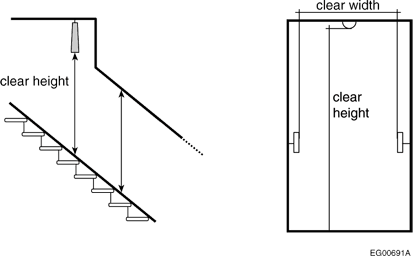
Figure A-3.4.3.4.
Measuring clear height
A-3.4.4.2.(2)(e) Requirements for Lobby
If an exit is permitted to lead through a lobby, the lobby
must provide a level of protection approaching that of the exit. As
well as meeting the width and height requirements for exits, the lobby
must be separated from the remainder of the building by a fire separation
having a fire-resistance rating at least equal to that required for
the exit, unless one of the exceptions in this Clause is applied.
A-3.4.5.1.(2)(c) Graphical Symbols for Exit Signs
ISO 7010, “Graphical symbols – Safety colours and safety signs – Safety signs used in workplaces and public areas,” identifies the following internationally recognized symbols for use at required
exits.
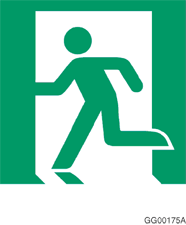
Figure A-3.4.5.1.(2)(c)-A
 “E001 Emergency exit (left hand)” symbol from ISO 7010
“E001 Emergency exit (left hand)” symbol from ISO 7010

Figure A-3.4.5.1.(2)(c)-B
 “E005 Direction, arrow (90° increments), safe condition” symbol from ISO 7010
“E005 Direction, arrow (90° increments), safe condition” symbol from ISO 7010

 A-3.4.5.1.(3) Internally Illuminated Signs
A-3.4.5.1.(3) Internally Illuminated SignsPhotoluminescent signs are not internally illuminated and therefore must conform to
Sentence 3.4.5.1.(4).

 A-3.4.5.1.(4) Externally Illuminated Signs
A-3.4.5.1.(4) Externally Illuminated SignsAn external lighting source is required to properly charge photoluminescent signs.
In addition to being continuously illuminated as required by Sentence 3.4.5.1.(4),
these types of signs must also be lit in conformance with the charging requirements
stated in CAN/ULC-S572.


A-3.4.6. Application to Means of Egress
The requirements in Subsection 3.4.6. apply to interior and exterior exits, as well
as to ramps, stairways and passageways used by the public as access
to exit. The treads, risers, landings, handrails and guards for the
latter access to exit facilities must thus be provided in conformance
with the appropriate requirements for exit facilities.
A-3.4.6.5.(8) Continuity of Handrail
Blind or visually-impaired persons rely on handrails to guide
them on stairways. A continuous handrail will assist them in negotiating
stairs at changes in direction. The extended handrail is useful to
persons with physical disabilities to steady themselves before using
the stairs. Handrails should, however, return to the wall, floor or
post, so as not to constitute a hazard to blind or visually-impaired
persons.
A-3.4.6.10.(5) Door Swing
Although
it is required that the door on the right hand side of a pair of doors
shall swing in the direction of travel through the exit, the direction
of swing of the door on the left side will depend on the function
of the horizontal exit. If the horizontal exit provides for movement
from one building to the adjacent building but does not require movement
in the reverse direction, both doors must swing in the direction of
travel to the adjacent building. If the design is based upon both
buildings providing complementary movement in either direction, then
the doors must swing in opposite directions. Location of a required
exit sign directly above a door that swings in the direction of travel
is deemed to meet the intent of Clause 3.4.6.10.(5)(b).
A-3.4.6.11.(3) Exit Concealment
Hangings or draperies placed over exit doors may conceal or obscure
them.
A-3.4.6.16.(1) Fastening Device
Turnpieces of a type which must be rotated through an angle of more
than 90° before releasing a locking bolt are not considered
to be readily openable. The release of a locking bolt should allow
the door to open without having to operate other devices on the door.
A-3.4.6.16.(4) Electromagnetic Lock
Electromagnetic locks are intended for use where there is a need
for security additional to that provided by traditional exit hardware.
They are not intended for indiscriminate use as alternative locking
devices. The design of these devices requires evaluation to ensure
that their operation will be fail-safe in allowing exiting in the
event of foreseeable emergencies. If more than one locking device
is used in a building, it is expected that one switch will release
and reset all devices simultaneously.
A-3.4.6.17.(1) Special Security for Doors
The need for security in banks and in mercantile occupancies
requires the ability to use positive locking devices on doors that
may not readily be opened from inside the building. In a fully sprinklered
building, the risk to persons inside the building is substantially
reduced. The provisions of Sentences 3.4.6.17.(2) to (9) assume that the area is illuminated and that a means of communication is available
to any occupant during times that the doors are locked.
A-3.4.6.19.(1)(d) Colour Contrast
The identification of floor and other signs intended to facilitate
orientation for visually-impaired persons should offer maximum colour
contrast to be effective. For this reason, it is recommended that
white on black or black on white be used, as this combination produces
the best legibility. It is also recommended that the sign surfaces
be processed to prevent glare.
A-3.5.2.1.(1) Elevator Design
The reference to “the British Columbia Elevating Devices Safety Regulation” in this
Sentence implies
conformance with all requirements of that standard for elevator cars, hoistways,
pits and machine rooms, including restrictions on other services in these areas and
detailed design criteria.

A-3.5.4.1.(1) Elevator Car Dimensions
In some circumstances it is necessary to maintain a patient
on a stretcher in the prone position during transit to a hospital
or to treatment facilities. Inclining the stretcher to load it into
an elevator could be fatal or at the very least detrimental to the
patient's health. Many ambulance services use a mobile patient stretcher
whose size is 2 010 mm long and 610 mm wide.
As well as space for the stretcher in the elevator, there should be
sufficient additional space for at least two attendants who may also
be providing treatment during transit. Common elevator units that
can satisfy this requirement include:
- a 1 134 kg elevator car with minimum interior dimensions of 2 032 mm wide and 1 295 mm deep with a right or left hand access door. The minimum access door width is 1 067 mm and it must be on the 2 032 mm side of the car.
- a 1 134 kg elevator car with minimum interior dimensions of 2 032 mm deep and 1 295 mm wide with a minimum 915 mm wide access door located on the 1 295 mm side.
A-3.6.2.5.(1) Combustible Refuse Storage
Storage of refuse consisting of combustible materials including waste paper,
cardboard and plastic, and noncombustible materials such as glass and metallic
containers can be accumulated in these rooms for the purpose of recycling. This
storage is allowed in consideration of a less stringent collection schedule when
compared to that of garbage or refuse, which is collected regularly.
A-3.6.2.7.(5) Explosion Relief
Examples of good engineering practice for this application can be
found in NFPA 68, “Explosion Protection by Deflagration Venting,” NFPA 69, “Explosion Prevention Systems,” and NFPA FPH 2008, “Fire Protection Handbook.”
A-3.6.3.1.(1) Vertical Service Spaces
Sentence 3.6.3.1.(1) does not prohibit the internal subdivision of a vertical service space to allow different building services to
be installed in physically separated spaces unless other requirements
apply (see, for example, Sentences 3.2.7.10.(2) and (3)). Fire separation requirements apply to the perimeter of the group of service spaces. Article 3.6.3.3. has special requirements for linen chutes and refuse chutes.
A-3.6.4.2.(2) Ceiling Membrane Rating
In construction assemblies that utilize membrane ceiling protection
and have been assigned a fire-resistance rating on the basis of a
fire test, the membrane is only one of the elements that contribute
to the performance of the assembly and does not in itself provide
the protection implied by the rating. For the fire-resistance rating
of membrane materials used in this form of construction, reference
should be made to the results of fire tests which have been conducted
to specifically evaluate the performance of this element.
A-3.6.5.6.(2) Clearance for Warm-Air Supply Ducts
Applicable to forced-air furnaces where permissible clearance C above plenum is
75 mm or less.
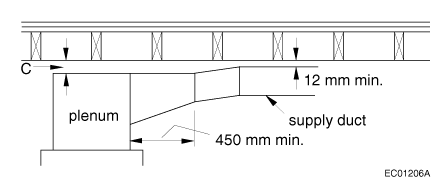
Figure A-3.6.5.6.(2)
Clearance for warm-air supply ducts
A-3.6.5.6.(3) Clearance for Warm-Air Supply Ducts
Applicable to forced-air furnaces where permissible clearance C above plenum is
more than 75 mm but not more than 150 mm.
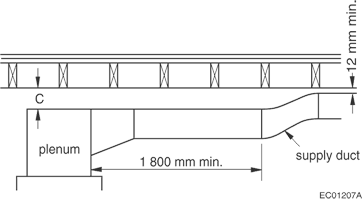
Figure A-3.6.5.6.(3)
Clearance for warm-air supply ducts
A-3.6.5.6.(4) Clearance for Warm-Air Supply Ducts
Applicable to forced-air furnaces where permissible clearance C above plenum is
more than 150 mm.
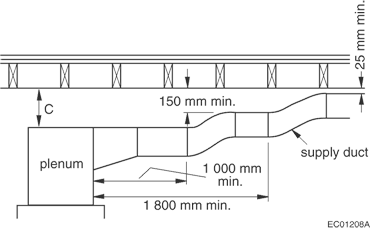
Figure A-3.6.5.6.(4)
Clearance for warm-air supply ducts
A-3.7.2.2.(1) Water Closets
Sentence 3.7.2.2.(1) assumes that there will be a sufficient number of persons in the building to justify the provision of separate water closet facilities for both males and females. In some
circumstances overall low occupant loads would not require more than one water closet
for males and one water closet for females and yet the building has more than one
storey. It is deemed that rooms each containing a single water closet available for
both males and females would satisfy the intent of the Code. The total number of water
closets must be adequate for the total number of occupants. Requirements for barrier
free accessibility also need to be considered. If the entrance storey is accessible
and the upper storeys are not required to be accessible, a room in the accessible
storey must meet the requirements of Section 3.8. and can serve both males and females. If provided, a nonaccessible room, designed
to serve both males and females, in each nonaccessible upper storey would be acceptable.
Sentence 3.7.2.2.(4) permits a single water closet to serve both males and females if the total occupant load is low.
A-3.7.2.10.(3)(b) Accessible Water Closets
Wheelchair users generally require a higher toilet seat to facilitate transfer
from their chair to the toilet. Removable high-lift seats are not acceptable in
public washrooms as they will most likely disappear or be damaged. Permanently
installed vandal resistant high-lift seats are available for installation on
standard height toilet bowls and these could be considered in place of the high bowl
required by this Clause.
A-3.7.2.10.(10)(h) Shower Doors
Shower doors are not permitted because those generally available impede access for
disabled persons to the tub or shower or are difficult for disabled persons to
operate. This Clause is not intended to prohibit shower curtains.
A-3.8. Accessible Design Assumptions
This Section contains minimum provisions to accommodate a person using a typical
manual wheelchair or other manual mobility assistance devices such as walking aids,
including canes, crutches, braces and artificial limbs.
Building Access Handbook
An illustrated guide and commentary has been produced to assist users of
Section 3.8 and other access requirements of the British Columbia Building Code.
This handbook contains the entire text of Section 3.8. and other access
requirements, and is supplemented by commentary and illustrations on specific
requirements where necessary.

 A-3.8.1.1. BC Deleted
A-3.8.1.1. BC Deleted
A-3.8.1.2. BC Deleted

A-3.8.1.4.(1) BC Deleted

A-3.8.2.1. BC Deleted


A-3.8.2.1.(2)(a) Access to Small Storeys
Elevators and elevating devices for people with disabilities are relatively
expensive and in small buildings they may form a significant percentage of a
building's cost. This Clause is intended to exempt such small second storeys or
basements from access requirements when they are self-contained or contain the same
facilities as on the first storey. Examples where access is not required are office
tenants on the second storey of a small building and the second storey of a
restaurant which contains only additional seating. If, on the other hand, the
restaurant's washrooms are in the less than 600 m2 basement there must be access to
them as they are an integral part of the principle function on the first storey.
Likewise, staff lunchrooms and washrooms are integral with the principle function
and when they are on a small second storey or mezzanine they must be accessible when
a disabled person could reasonably be expected to be employed there.
This exemption applies to buildings of two storeys in building height containing
not more than three storeys. A building of three or more storeys in building height
must be fully accessible.
A-3.8.2.1.(2)(e) Small Mercantile Occupancies
Any individual Group E shop with a total retail floor space of less than 50 m2 is
exempt from the requirements of Section 3.8. A building could contain several such
stores and each one would be exempt from the access requirements although other
large stores and the building containing them all would be accessible.
A-3.8.2.2. BC Deleted

 A-3.8.2.2.(1) BC Deleted
A-3.8.2.2.(1) BC Deleted

A-3.8.2.3. BC Deleted

A-3.8.2.3.(2) Universal Toilet Rooms
Clause (2)(a) requires an accessible universal toilet room in every building
required to have water closets. There are a significant number of disabled persons
whose daily lives depend heavily on assistance from their spouse or a care giver of
the opposite sex. This companion is precluded from assisting in multiple stall
public washrooms. The universal toilet room not only solves this problem but also
serves the needs of other disabled persons who simply prefer the relative ease of
using a toilet room. It can also serve as a washroom for parents with small children
and, with the addition of a counter, as a changing room for infants.
A-3.8.2.36.(2) Mercantile Buildings
Where fitting rooms are provided in a store an accessible fitting room is
required. An enclosure about 1 500 mm by 1 500 mm is
suggested.
 A-3.8.3.1.(1) to (3) BC Deleted
A-3.8.3.1.(1) to (3) BC Deleted
A-3.8.3.1.(4) BC Deleted

A-3.8.3.3.(1) BC Deleted

A-3.8.3.3.(2) BC Deleted

A-3.8.3.3.(3) BC Deleted


A-3.8.3.3.(5) Doors with Power Operators
Doors equipped with a power operator actuated by a pressure plate identified with
the international symbol for accessibility or, where security is required, by a key,
card or radio transmitter, and that can otherwise be opened manually, meet the
intent of the requirement. The location of these actuating devices should ensure
that a wheelchair will not interfere with the operation of the door once it is
actuated. Swinging doors equipped with power operators which are actuated
automatically and open into passing pedestrian traffic should be provided with a
guard or other device designed to prevent pedestrians from stepping in the swing
area of the door. These guards or devices should be detectable by blind persons. For
example, inverted U-shaped guards should have an additional rail at a height not
more than 680 mm so that it is detectable by the long cane. These doors
should also have a device (mat or other sensor) on the swing side to prevent the
door from opening if someone is standing in the swing area.
 A-3.8.3.3.(8) BC Deleted
A-3.8.3.3.(8) BC Deleted
A-3.8.3.3.(9) BC Deleted

A-3.8.3.3.(10) BC Deleted

A-3.8.3.4.(1)(b) BC Deleted

A-3.8.3.4.(1)(c) BC Deleted


A-3.8.3.5.(4) Doors with Power Operators
Doors equipped with a power operator actuated by a pressure plate identified with
the international symbol for accessibility or, where security is required, by a key,
card or radio transmitter, and that can otherwise be opened manually, meet the
intent of the requirement. The location of these actuating devices should ensure
that a wheelchair will not interfere with the operation of the door once it is
actuated. Swinging doors equipped with power operators which are actuated
automatically and open into passing pedestrian traffic should be provided with a
guard or other device designed to prevent pedestrians from stepping in the swing
area of the door. These guards or devices should be detectable by blind persons. For
example, inverted U-shaped guards should have an additional rail at a height not
more than 680 mm so that it is detectable by the long cane. These doors
should also have a device (mat or other sensor) on the swing side to prevent the
door from opening if someone is standing in the swing area.
 A-3.8.3.7. BC Deleted
A-3.8.3.7. BC Deleted
A-3.8.3.8.(1)(b)(iii) BC Deleted

A-3.8.3.8.(1)(b)(iv) BC Deleted

A-3.8.3.8.(1)(d)(i) BC Deleted

A-3.8.3.9.(1) BC Deleted


A-3.8.3.11. Tactile Warning System
The diagrams below illustrate one acceptable design of tactile
warning strip.
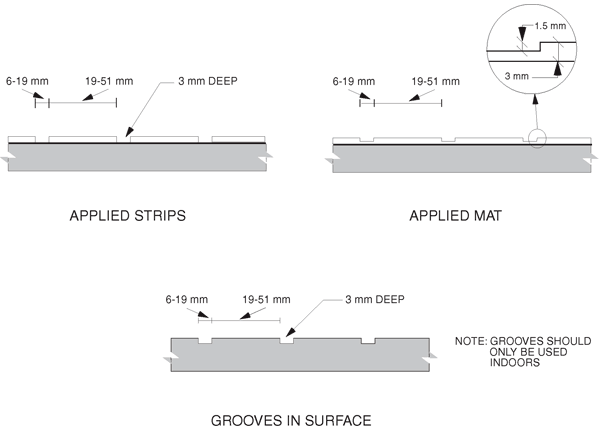
Figure A-3.8.3.11.
Tactile Surfaces
A-3.8.3.11.(1)(c) BC Deleted

 A-3.8.3.11.(1)(d) BC Deleted
A-3.8.3.11.(1)(d) BC Deleted
A-3.8.3.12. BC Deleted


A-3.8.3.13.(1)(b) BC Deleted

 A-3.8.3.13.(1)(f) BC Deleted
A-3.8.3.13.(1)(f) BC Deleted
A-3.8.3.14.(1) BC Deleted


A-3.8.3.15. BC Deleted

A-3.8.3.16.(1)(d) Telephone Shelf
Many hearing impaired persons use a telecommunication device for the deaf (TDD)
with a standard telephone to communicate visually. A shelf is needed to hold this
device.
A-3.8.3.18.(1) Accessible Counters
Extended business transactions are activities such as personal banking or
purchasing insurance where discussion and negotiations take place and documents need
to read and/or signed. This provision is not intended to apply to the simple
exchange of money for goods or services such as at a retail check-out counter or
ticket kiosk.
A-3.8.3.19. Temporary Refuge for Persons with Disabilities
These measures are intended to provide temporary refuge for persons with
disabilities. It is acknowledged, however, that the measures cannot provide absolute
safety for all occupants in the fire area. It may, therefore, be necessary to
develop special arrangements in the fire safety plan to evacuate persons with
disabilities from these areas. Details for a suitable plan are contained in the
British Columbia Fire Code.
The protected elevator referred to in Clause 3.8.3.19.(1)(a) is intended to be
used by fire fighters as a means for evacuating persons with disabilities. It is not
intended that this elevator be used by persons with disabilities as a means of
egress without the assistance of fire fighters.
If an estimate is to be made of the number of persons with disabilities in a floor
area who can be accommodated in each zone in Clause 3.8.3.19.(1)(b), this estimate
may be based on Table 3.8.2.5., which is used to determine the minimum number of
spaces to be provided for wheelchair occupants in fixed seating areas. If more
precise information is available, it should be used for sizing the zones.
A-3.8.3.20. Assistive Listening Systems
Wireless sound transmission systems, including FM, infrared or magnetic induction
loop systems, improve sound reception for persons with hearing disabilities by
providing amplification which can be adjusted by each user while blocking out
unwanted background noise. These systems transmit a signal that is picked up by a
special receiver available for use by a person with a hearing disability, whether
or
not a hearing aid is used. Neither system interferes with the listening enjoyment
of
others.
The transmitter can be jacked into an existing P.A. system amplifier or used
independently with microphones. The induction loop system requires users to sit in
the area circumscribed by the loop; though installation of the loop is relatively
simple, the installer should be knowledgeable about these systems if proper
functioning is to be achieved. FM or infrared systems can be designed to broadcast
signals which cover the entire room and thus do not restrict seating to any one
area. and show the general configuration of FM and infrared systems. Although
portable systems (FM in particular) are available, these are best suited to small
audiences. Generally, the systems installed in church halls, auditoria, theatres and
similar places of assembly are not easily portable, as they are installed in a fixed
location by a sound technician and form an integral part of the P.A. system of the
room or building.
Hard-wired systems (where a jack is provided at a particular seat) will not meet
this requirement unless adequate provisions are made to accommodate persons with
hearing aids. In choosing the most appropriate system, a number of factors must be
taken into account including cost, installation and maintenance, suitability to the
audience, ease of operation and the need for privacy. Information on designers and
suppliers of these systems may be obtained from the Canadian Hearing Society.
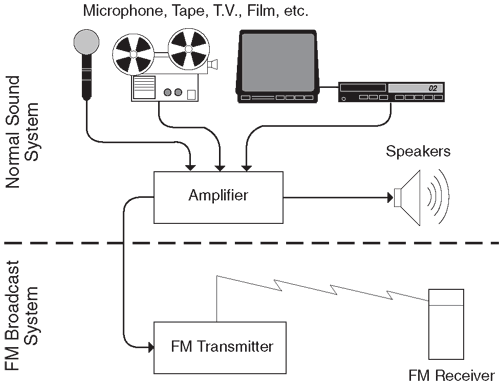
Figure A-3.8.3.20.-A-A
FM sound transmission system
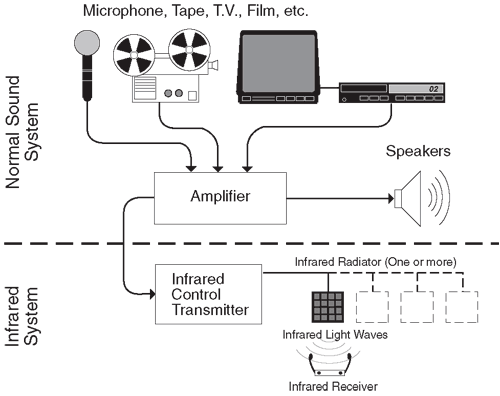
Figure A-3.8.3.20.-B-B
Infrared sound transmission system
A-3.8.5.5.(2) Grab Bar Installation.
This provision is intended to ensure there is adequate backing for the
installation of grab bars by a future occupant of the adaptable dwelling unit.
Plywood, waterboard, particleboard or solid lumber behind the wall finish and
encompassing the location of future grab bars located as described in Clause 3.7.2.10.(4)(a) and Clause 3.7.2.10.(10)(j) or 3.7.2.10.(11)(j) would provide suitable
backing for the grab bar fasteners.
